WEST COAST NUT
OCTOBER 2023 ISSUE
SPOTLIGHT:
BALANCING SOIL BIOLOGY IS A MUST FOR THE MODERN-DAY TREE NUT GROWER
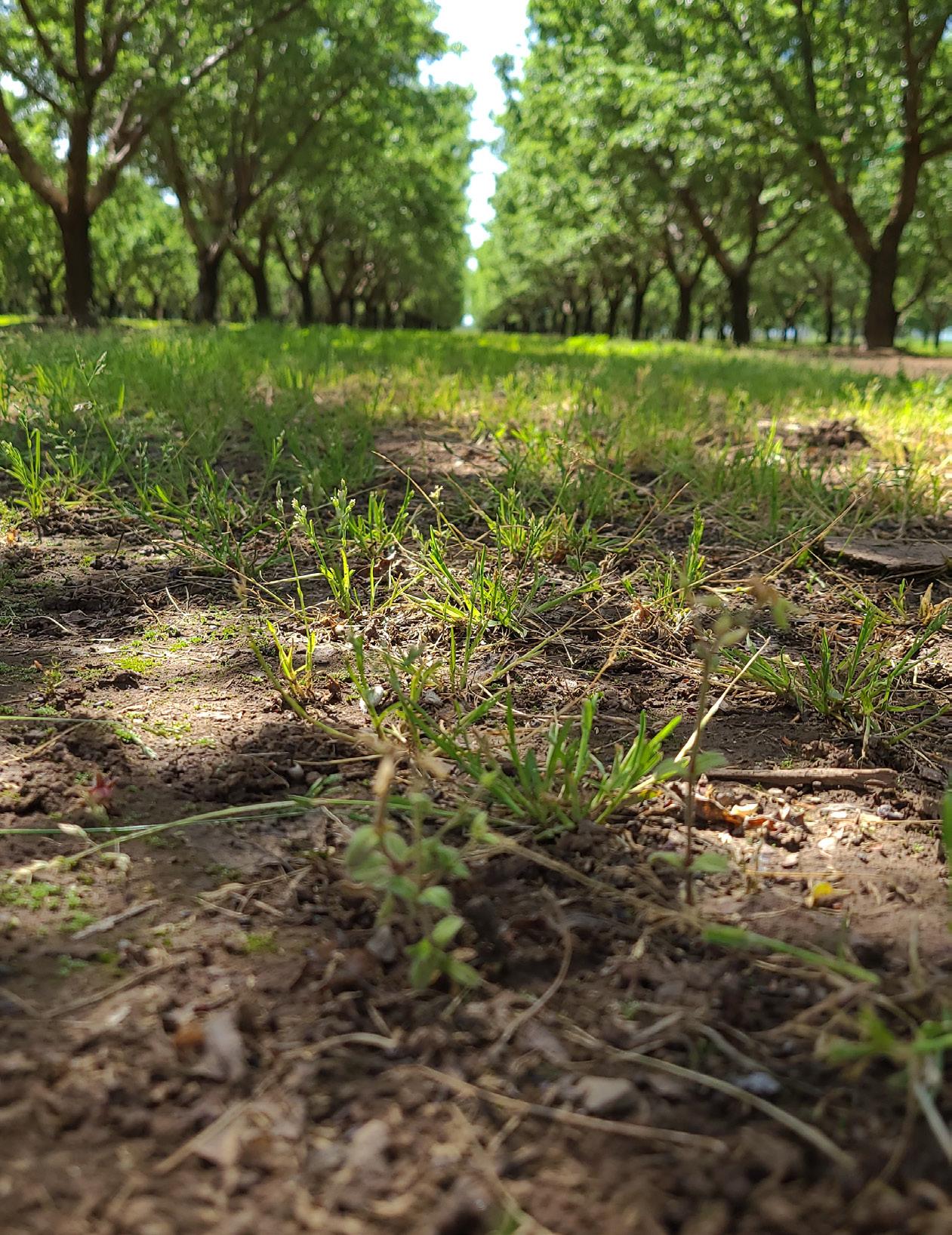
SEE PAGE 14
IN THIS ISSUE:
CONTIGUOUS ACRES, LESS FALLOWING MAKES IT HARDER TO BREAK THE DISEASE CYCLE SEE PAGE 4
TIMING, PREPARATION ARE KEYS TO SUCCESS WITH PREEMERGENT HERBICIDE PROGRAMS SEE PAGE 48
BY REAL CALIFORNIANS
NOVEMBER 2, 2023
FOR MORE INFORMATION SEE PAGES 32-33
PUBLICATION
Photo by T. Chalstrom
PRODUCED IN THE HEART OF
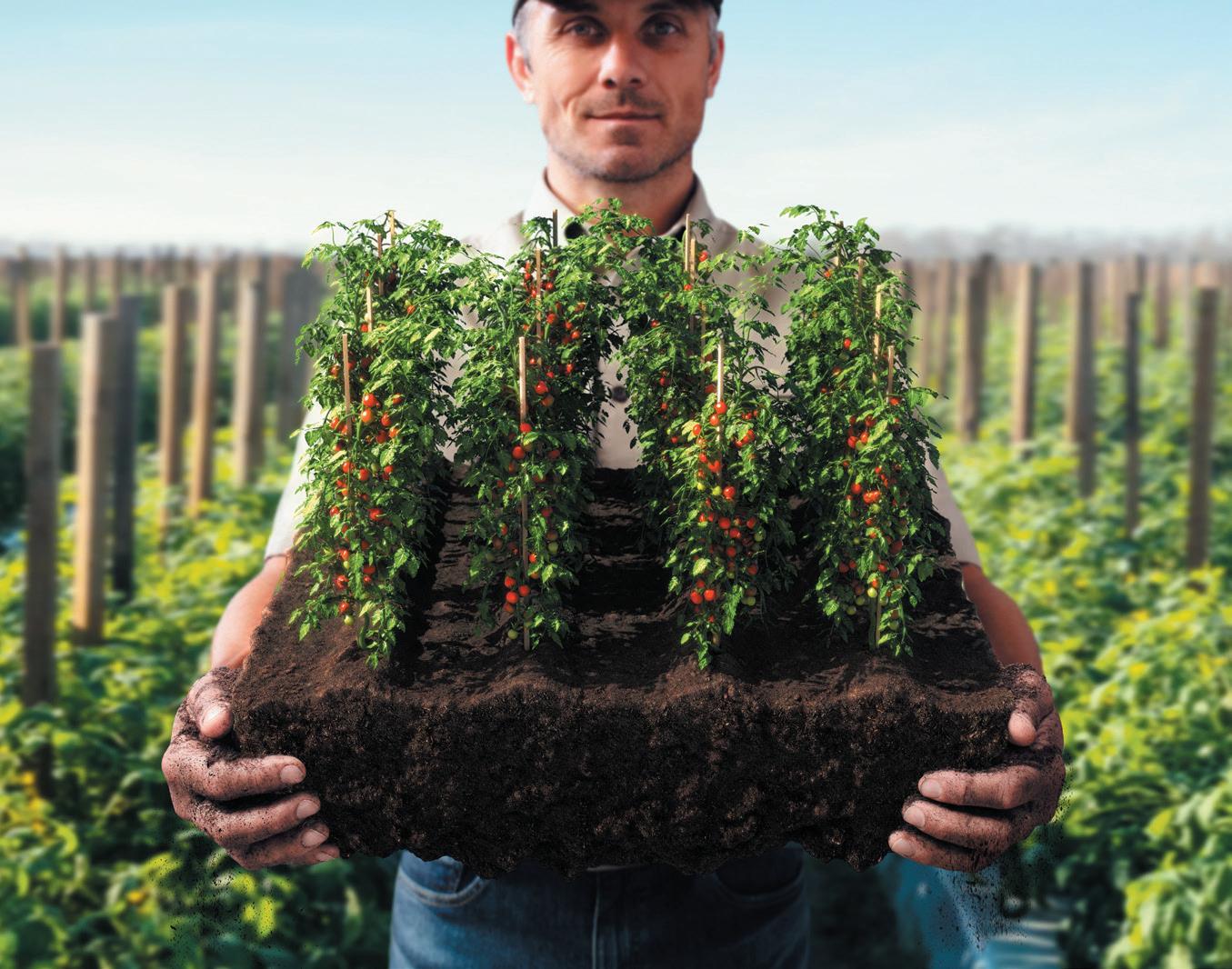
Elevate your crop. Elevate your harvest. Salibro™ nematicide with Reklemel™ active is a first-of-a-kind nematicide that targets plant-parasitic nematodes yet is gentle on many beneficial organisms in the soil. You get the best of both worlds: a productive crop today and healthy soils for tomorrow. See the benefits at Corteva.us/SalibroNematicide. Introducing a new way to control damaging nematodes to enhance crop yield and quality. Trademarks of Corteva Agriscience and its affiliated companies. Reklemel is a registered active ingredient. Salibro is not registered for sale or use in all states. Contact your state pesticide regulatory agency to determine if a product is registered for sale or use in your state. Always read and follow label directions. © 2023 Corteva. CA38-449-021 (08/23) BR CAAG2SBRO051
Publisher: Jason Scott
Email: jason@jcsmarketinginc.com
Editor: Marni Katz
Email: marni@jcsmarketinginc.com
Associate Editor: Cecilia Parsons
Email: cecilia@jcsmarketinginc.com
Production: design@jcsmarketinginc.com
Tel: 559.352.4456
Fax: 559.472.3113
Web: www.wcngg.com
Award Winning Editorial By the Industry, For the Industry IN THIS
Almond Board of California
Contributing Writer
Vicky Boyd
Contributing Writer
Lori Fairchild
Contributing Writer
Rich Kreps CCA, SSp., Contributing Writer
Mitch Lies
Contributing Writer
Chris McGlothlin Director of Technical Services, Western Agricultural Processors Association
Catherine Merlo Contributing Writer
Franz Niederholzer UCCE Farm Advisor, Colusa and Sutter/Yuba Counties
Tobias Oker UCCE Soils and Irrigation Advisor, Kern County
Kristin Platts Digital Content Editor
Surendra K. Dara Director, North Willamette Research and Extension Center
Kevin Day County Director/UCCE Pomology Farm Advisor, Tulare/Kings Counties
Elizabeth Fichtner
UCCE Farm Advisor, Tulare County
Katherine Jarvis-Shean UCCE Area Orchard Systems Advisor, Yolo and Solano
Steven Koike Tri-Cal Diagnostics
Jhalendra Rijal UCCE Integrated Pest Management Advisor, Stanislaus County
Mohammad Yaghmour UCCE Area Orchard Systems Advisor, Kern County
responsibility for the opinions given in the publication.
BalancingSoilBiologyisaMustfortheModern-DayTreeNutGrower
Contributing Writer Rich Kreps, CCA, SSp, reminds growers about the connection between healthy, productive crops and soil biology and what nut growers can do to get there.
View our ePublication on the web at www.wcngg.com See page 14
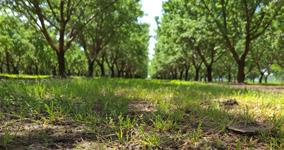
4 Contiguous Acres, Less Fallowing Makes it Harder to Break the Disease Cycle 8 California Honeybee Health Improved in 2023 12 State Water Board Fees on the Rise…Again 14 Balancing Soil Biology is a Must for the Modern-Day Tree Nut Grower 18 Alternatives to Fumigation in Almonds: Rice Bran Applications and ASD 22 Remembering Bill Tos 26 View from the Top: Jim Zion Is Betting on Pistachios 30 Putting the Pieces Together When Choosing the Right Rootstock 36 Third-Party Firm Evaluates Almond Board’s Marketing Efforts in Post-Pandemic World 40 Sacramento Valley Nut Orchards: Fall Considerations 44 Labor, Cost Savings Highlighted at Nut Growers Society Summer Tour in Oregon 48 Timing, Preparation Are Keys to Success with Preemergent Herbicide Programs 52 Researchers Present Data on Preplant Alternatives for Nematodes in Walnuts at Field Day 56 Pushing the Limits of Irrigation Efficiency: What Is Possible? 60 From the Orchard: Stephani Graham and Rebecca Kaser Sisters Set Example for Women in the Tree Nut Industry Contributing Writers & Industry Support
UC
Cooperative Extension Advisory Board
articles,
advertisements
publication
The
research, industry updates, company profiles, and
in this
are the professional opinions of writers and advertisers. West Coast Nut does not assume any
ISSUE
October 2023 www.wcngg.com 3
Contiguous Acres, Less Fallowing Make it Harder to Break the Disease Cycle
By MITCH LIES | Contributing Writer
The plethora of tree nut acres in California agriculture is increasing disease pressure, both from soilborne pathogens that survive from one planting to the next and from foliar pathogens spreading within and between orchards.

And with new restrictions looming on fumigation and more acres being planted in dense settings, the danger is things will only get worse, according to University of California plant pathologists.
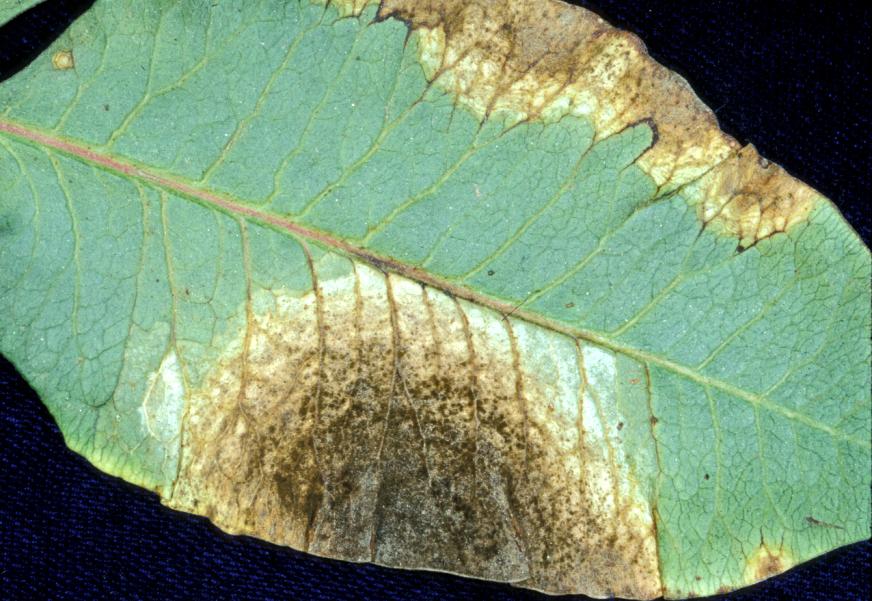
One issue of concern, according to UC plant pathologists, is that growers are planting orchards back to back without breaking disease cycles.
“Historically, the guidelines have always been to fumigate or to rotate to a different crop for a year or two, with rotation being the cheaper way to go,” said Jim Adaskaveg, professor and plant pathologist at UC Riverside. “But, obviously, the rotational crop probably doesn’t make the same amount of money, so the grower will usually want to plant back in almond or walnut or pistachio as soon as possible just because they know that it takes three to five years before they start getting income back.”
“The tree crops are very valuable,” added UC Davis Plant Pathologist Themis Michailides, “and because it takes three, four or five years to come into production, growers are anxious to plant as soon as possible to gain a
couple of years.”
The economics of planting back to back make sense, the pathologists said, but rushing into the next production cycle carries risks that can hamper production for years to come.
“Especially with walnuts and even with almonds, you can have replant issues because they have toxic materials in the degradation process of the older root systems,” Adaskaveg said. “A lot of it depends on how well you remove the old root systems. But you can have pathogens build up, nematodes build up in the soil, and that means that if you don’t do a rotation and just go right back into almond or go right back into walnut, you’ll potentially have a buildup of soilborne inoculum in that situation. And with all the restrictions on fumigation taking effect, people have to think about what they’re going to do in the sense of disease management.
“There are post-plant nematicides that can be used,” Adaskaveg added. “There are post-plant Phytophthora fungicides that can be applied. And so, there are options for the growers. But there is going to be a buildup of inoculum if these diseases aren’t managed.”
Intercropping
In the absence of fallowing land, many growers are intercropping with grains or vegetables to help minimize disease pressure from soilborne pathogens while optimizing use of
farm acres. The practice often involves offsetting tree rows from the previous orchard and planting an intercrop in the rows where the trees once were. The practice mitigates some risk by moving tree rows to where problems with nematodes are less intense, Adaskaveg said, and the intercrop can help reduce nematode pressure.
A crop like mustard greens can be particularly beneficial in these systems, Adaskaveg said. “The mustard greens will do a better job for that [than grains], and you only need to do that probably for a year, and then you can get back into getting ready for production in the second or third leaf of that orchard.”
But mustard greens can potentially bring in other pathogens, like Verticillium, he said. “If you do intercrop vegetable crops, you have to be very careful in what intercropping you are going to do,” Adaskaveg said.
“Obviously grain crops are less likely to be bringing in these other pathogens of tree crops,” he added. And, while not as effective in reducing nematode populations as mustard greens, grain crops nevertheless can benefit soils and lower pest pressure.
Ideally, the pathologists said, the best option is to fallow ground or raise a cover crop for a year before replanting an orchard. Michailides, who is
Leaf infections
ContinuedonPage6 4 West Coast Nut October 2023
Harness the Power of Ancient Sunlight
Welcome to Huma®. Inspired by one of the earth’s most precious resources, humus, we harness the power of ancient sunlight through humate-based products to vitalize life in soil and crops. Formerly known as Bio Huma Netics®, we have united our company name and our brands, Huma Gro®, Fertilgold® Organics, and Mesa Verde Humates®, under Huma®: a name that reflects the power and nurture of Mother Nature. We invite you to experience our humic solutions with a human touch. For more information visit: Huma.us or call us at 480-961-1220
Humic Solutions with a Human Touch ®

based at the Kearney Ag Research and Extension Center, said researchers at the center raise oats or an oat-vetch combination for one year between orchard plantings to reduce soilborne pathogens.
But researchers aren’t worried about generating income off the acres, he said, and so are more likely to take a year off. “The growers are probably anxious to get something back in the ground and make some money,” Michailides said.
“These are choices growers have to make,” Adaskaveg said.
Foliar Diseases


One issue that has emerged from the continued expansion of tree nut acres in California is an increase in foliar diseases, Michailides said, and much of that can be explained by a subsequent increase in relative humidity.
To illustrate the situation, Michailides noted that when he started with the University of California system in 1979, approximately 30,000 acres were planted to pistachios in California. Today, close to 450,000 acres of pistachio are growing in California. Almond acres also increased at a dramatic rate in that time span.
“And all of these acres have to be irrigated,” Michailides said, “and now you have large acreages of pistachios and almonds next to one another and it is almost like a continuous irrigated land, and that contributes to a tremendous increase in relative humidity. And now we have denser plantings, which also contribute to the increase of the relative humidity.”
Diseases that years ago were not a problem now are, Michailides said.
“Now Alternaria, which depends on very high relative humidity, has become a very serious and a very difficult-to-control disease,” Michailides said. “I would say it’s maybe a 30% increase in Alternaria compared to what we once had.”
Growers have several options for controlling Alternaria leaf spot in almonds and Alternaria late blight in pistachios and can take preventive steps to minimize their presence. In some cases, however, disease prevention is taken
out of a grower’s hands.
Take for example when a walnut orchard with an impact sprinkler system is adjacent to an almond orchard.
“If your land is adjacent to someone who is using different practices for their orchard, so if one guy has microsprinklers or drip and the other guy has an impact sprinkler, and it could be walnut next to almond or almond adjacent to almond, then those adjacent rows are going to be affected,” Adaskaveg said.
“In those cases, we see edge effects, where the humidity is higher and those first two or three rows next to a walnut orchard have more disease because the microclimate effects from the walnut
is affecting almonds,” Adaskaveg said. “And so, we see Alternaria leaf spot being more of a problem in that situation.
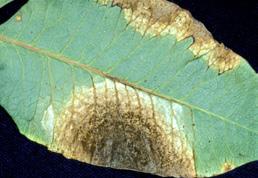
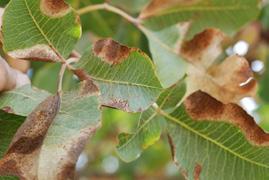
“Even though Alternaria is not a big deal in walnuts, because they are watering, it can affect the microclimate and the adjacent orchard gets more Alternaria leaf spot on the edge rows,” he said.
Michailides added even in those cases, growers can help minimize the chance of a disease spreading from one orchard to another through irrigation practices.

“Because it is airborne, Alternaria can spread from one orchard to another,” he said. “However, if an orchard is very dry due to the way the grower irrigates and it’s next to an orchard
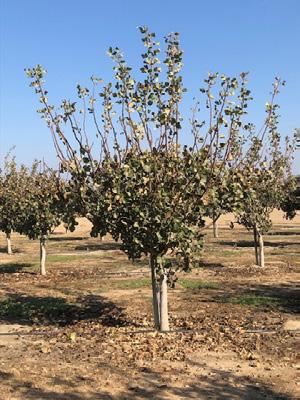
ContinuedfromPage4
Researchers are seeing increased incidences of Alternaria late blight in both the Kerman, left, and Golden Hills varieties of pistachio as more acres and the subsequent increase in irrigation has increased relative humidity across California farmland.
Alternaria late blight
Symptoms of Alternaria late blight on pistachio leaves include black angular or circular lesions. Leaf infections can lead to premature defoliation and difficulties at harvest.
Kerman
6 West Coast Nut October 2023
Golden Hills
with Alternaria, I think the chances for the Alternaria to develop in the adjacent orchard would be minimal.”
To illustrate this, Michailides noted that in one study, researchers were able to show a 50% reduction in disease incidence between an orchard using flood irrigation and one using subsur-


face irrigation. “It changed not only the relative humidity, but also the temperature was affected,” Michailides said. “It was two to three degrees higher in the subsurface irrigation blocks.”
Between good irrigation management, intercropping, fallowing when possible, scouting and chemical
controls, growers should be able to stay ahead of diseases in orchard nut crops, researchers said. But it appears to be getting more difficult.

Comments about this article? We want to hear from you. Feel free to email us at article@jcsmarketinginc.com
The Almond Conference brings together growers and other industry stakeholders to serve as the premier gathering for networking, education and research in the almond industry. The conference promotes collaboration by fostering a sense of community among all those who are committed to the success of California’s almond industry.
Don’t miss out learn more and register at Almonds.com/Conference

SAFE CREDIT UNION CONVENTION CENTER DOWNTOWN SACRAMENTO
© 2023 Almond Board of California. All rights reserved. VISIT Document# 2023IR0068
ect of subsurface irrigation on Alternaria late blight
Effect of subsurface irrigation on Alternaria late blight
October 2023 www.wcngg.com 7
Researchers measured a dramatic difference in relative humidity between flood-irrigated and drip-irrigated pistachio orchards and a subsequent dramatic increase in percentage of leaves infected with Alternaria late blight in this 1994 study. The study shows how differences in relative humidity can increase disease pressure in pistachios.
CALIFORNIA HONEYBEE HEALTH IMPROVED IN 2023 ABUNDANCE OF NATURAL FORAGE HELPED BOOST COLONY HEALTH IN 2023 AND BEE SUPPLY OUTLOOK FOR 2024
By CECILIA PARSONS | Associate Editor

In California, winter and spring 2023 will be remembered for the rain and cold and its effect on almond bloom and pollination. The weather also had a dramatic effect on pollinators, Billy Synk, habitat specialist for Pollinator Partnership, said.
“It was a different year; flight hours for bees were reduced, yet pollination happened in some orchards, while not in others,” Synk said. “The weather had a dramatic effect on managed and
native pollinators.”
On a positive note, Gene Brandi, a Los Banos-area commercial beekeeper and former president of the American Beekeeping Federation, said the 2023 winter and spring rains provided managed bees and native pollinators with a great deal of natural forage that had not been available since 2019. He said bees were able to produce sage, buckwheat, toyon and other honeys in the spring and early summer. Abun-
dant bluecurl and tarweed plants emerged and have been supplying pollen and nectar during the later summer and early fall period, which greatly helps with bees’ nutritional needs as colonies prepare for the winter.
“Wet years are generally good years for bees in California as long as hives don’t get flooded or washed away,” Brandi said.
Steve House, master beekeeper and director of operations for California Almond Pollination Service Inc., said many California beekeepers recorded record honey production this year due to abundance of natural and planted forage. In addition, he said most beekeepers also reported 30% to 50% more bees were produced than in previous years.
“Colonies were healthier and productive and were also able to combat mites and various viruses. Good nutrition helped bees survive and tolerate disease and mites,” House said.
USDA-NASS Survey
A USDA-NASS survey from August 2023 reported that honeybee colonies added to operations with more than five colonies from January to March was 384,790. During the quarter from April to June, 573,160 colonies were added, the highest number of honeybee colonies added for any quarter surveyed in 2022. The number one stressor for managed bees throughout the U.S. the USDA report noted, was varroa mites with 50% of colonies affected through June. There was also an increase in bee colonies lost to Colony Collapse Disorder nationwide. The survey represented 12% of the estimated 2.70 million managed honey-producing colonies in the U.S. in 2022
House said he believes the 2024 pollination season should be good for almond growers with adequate supplies of strong colonies expected.
He did note that demand for pollination services may be less due to orchard removals. A USDA report shows California almond acreage decreased in 2022 for the first time in more than 25

ContinuedonPage10
8 West Coast Nut October 2023
The bee supply outlook for 2024 is positive, according to beekeepers.
Power ed by HEXA™
AgroPlantae’ s HEXA™ Technology is an advanced agricultural solution that unites traditional fertilizers with regenerative soil practices.

It consists of two product lines: HEXA TEAM, an NPK range, and HEXA TECH, a micronutrient line, both powered by HEXA™ Technology. These products contain six plant active ingredients and certified Organic Matter (OM), benefiting the soil by enhancing its structure, nutrient availability, water retention, and fostering an environment for thriving soil biology and their numerous associated advantages.
HEXA™ Technology enhances NPK with plant extracts, providing an energy boost that optimizes physiological processes supporting cropland and reducing yield losses due to stress. It also positively impacts crop quality attributes like sugar content, weight, and size.
HEXA TEAM is formulated with highly available forms of nutrients, maximizing crop utilization while minimizing environmental and soil losses. This is achieved through a two fold approach:
1. Using concentrated and readily available nutrient forms.
2. Increasing OM in the rhizosphere and invigorating biology to stimulate soil and maintain nutrients for immediate and future use.
HEXA TECH is a line of soil applied micronutrients featuring natural plant extract chelation, powered by HEXA™. It represents the most effective, biodegradable, and sustainable natural based chelate available. The plant extracts and amino acids act as carriers for micronutrients, ensuring rapid uptake and adding a biostimulant growth action, leading to stronger crops.
Trials conducted in soils (pH 8.2 8.8) compared HEXA TECH Cu, Zn, and Mn to traditional EDTA. HEXA TECH demonstrated higher efficiency and easier absorption than EDTA micronutrients, making it a superior choice for growers.

Visit AGROPLANTAE.COM or give us a call (559) 498 0388 to learn more Advertorial
Figure 1. Micronutrient foliar concentrations of Cu, Mn, and Zn for GS EDTA (gray) and HEXA TECH (yellow).
HEXA TECH vs EDTA Micronutrients
ContinuedfromPage8
years, despite a slight increase in bearing acres. House said he is seeing growers shrink their hive count per acre to 1.5 hives, down from two.

In addition to the increase on natural pollinator forage due to the wet winter, more acres of planted cover crops in orchards and adjacent areas have contributed to bee health. House said he is planning to plant cover crops the first week of October.
“All our bee yards from Chico to Tulare County have bee forage crops planted to provide nutrition prior to and after almond bloom, House said.
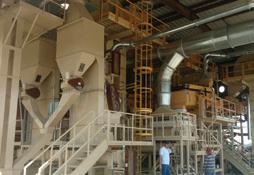
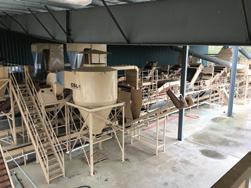


As growers look ahead to the next growing season, Synk said many are adopting cover cropping and other practices that encourage bee activity and health.
Cold, wet weather, disease and mites all affect beehive strength, but Synk maintains the biggest threat to pollinator health is the lack of abundant and diverse nutrition.
“Pathogens, pesticides and sickness are always threats, but the thing that affects bee colonies is nutrition. Arriving in almond orchards early in the year, bees may not have access to forage. Beekeepers provide supplemental pollen to hold them until bloom, but Synk compared that to eating a candy bar for breakfast and expecting strong, growing hives at bloom.
At bloom, he said a growing population of bees is desired for successful pollination. Growing hives have a higher ratio of worker bees to ‘in-hive’ bees. Growers may be overpaying for pollination services when hives are only at medium

WALNUTS & ALMONDS WALNUT AND ALMOND PROCESSING EQUIPMENT Contact Us Today 3200 TU LLY ROAD, H UG H SON, CA • G ro ssi fa b r i ca ti on.co m 20 9.8 83.28 17 Serving the California Walnut & Almond Industry for over 25 years. Custom Sizing to Fit Your Needs CONTACT US TODAY TO GET A QUOTE FOR THE BEST PRICES • Receiving • Precleaning • Hulling • Drying • In-Shell • Shelling • Eletronic Sorting • Hand Sorting • Packaging Receiving • Precleaning Hulling • In-Shell • Shelling • Almond Drying • Eletronic Sorting Hand Sorting • Packaging • Walnut Equipment Almond Equipment 10 West Coast Nut October 2023
Rains brought additional bee forage that led to healthier hives and stronger bees better able to resist stress from mites (all photos courtesy courtesy Almond Board of California.)
strength. Strong, 11- to 12-frame hives deliver more bees for the money.
Stetcyn Maldonado, program manager for Seeds for Bees, said pollination in 2024 will depend heavily on how managed honeybees overwinter this year. Many out-of-state beekeepers move hives into California for pollination, but Maldonado said large weather events including Florida hurricanes or drought can reduce colony numbers. She also noted a record number of applications to the Seeds for Bees program this year, and there may be more than 20,000 acres enrolled.
Best Management Practices
Almond Board of California’s (ABC) Honeybee Best Management Practices stress early communication between beekeepers, bee brokers, growers and applicators. The concern is how to manage the use of pest control materials to minimize potential impact on honeybees and other pollinators. County agriculture commissioners recommend hive registration in the Bee Where program by beekeepers. This allows applicators to see hive locations within a one-mile radius of a planned
spray application and provides contact information for notifications. ABC notes that all pollination stakeholders should note that the 1-mile buffer is not complete protection as bees can forage for up to 4 miles away from hives to collect food and find water sources.
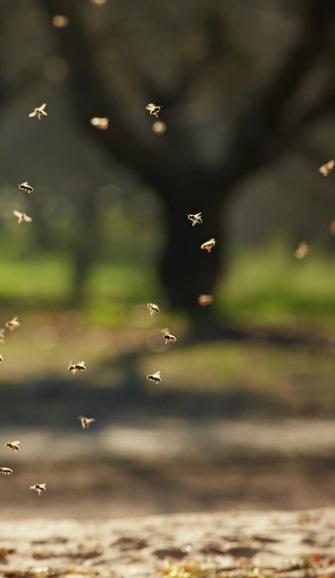
Josette Lewis, ABC’s chief scientific officer, adds that “almonds and bees are really a partnership designed by nature. Bees are an essential input to growing almonds and, in return, honeybee hives leave almond orchards in the spring with more bees than they came in with. We can see how much almond growers recognize the value of pollinators by the efforts in the last few years that growers have made to add more pollinator habitat and forage in and around orchards, habitat that benefits all pollinators, not just honeybees. About 170,000 acres of almonds have been certified as Bee Friendly Farms, and we have seen planting of pollinator specific cover crops increase by threefold in just a few years.”
To further enhance pollinator
habitat and managed bee health, Blue Diamond Growers recently announced a partnership program that includes offering almond growers no-cost cover crop seed and financial incentive for implementing cover crops or conservation cover on their land. Growers will work with Pollinator Partnership and Project Apis m. Blue Diamond also noted more than 15% of their growers’ orchards are certified in the Pollinator Partnership’s Bee Friendly Farming program.
This program is overseen by a task force of experts from the North American Pollinator Protection Campaign (NAPPC) including scientists and farmers and sets standards for planting pollinator food resources, providing nesting habitat and incorporating an integrated pest management strategy.
Comments about this article? We want to hear from you. Feel free to email us at article@jcsmarketinginc.com

October 2023 www.wcngg.com 11
State Water Board Fees on the Rise… Again
By CHRIS MCGLOTHLIN
Farms and commodity processing facilities are no strangers to compliance fees. Fees are levied from the local, state and federal levels amongst

various agencies. For the most part, yearly permit costs remain predictable. There may be inclusions of other programs or regulations they are required
WAPA has reminded the State Water Board that their fees are significantly higher than the cost of compliance of similar administration fees from other agencies and also going up disproportionately.
to comply with and pay for, but many businesses can expect specific fees from specific agencies. However, there is one California agency whose fees have increased by over 150% over the past seven years, resulting in increases to permits that already cost tens of thousands of dollars annually.
The State Water Resources Control Board (State Board/SWB) oversees two programs the agricultural industry must pay into to maintain compliance with the agency. For the tree nut hulling and processing industry, applicable businesses must pay into the Waste Discharge Program (WDR). Businesses are assessed fees based on the threat and complexity level. This evaluation considers the practices of the business directly related to the use and discharge of water on site and the quantity of water used. Tree nut operations subject to the WDR requirements and permit fees include pistachio hullers and processors and almond processors who blanch. The WDR program requires an annual report submission, detailing water sampling and evaluation that is conducted quarterly (and paid for by the permitted business.) These program fees pay for staff’s time in evaluating the report submissions annually.
Earlier this summer, State Board staff held a stakeholder meeting to discuss their anticipated budget for the 2023-24 season. At this meeting, staff
 |Director of Technical Services, Western Agricultural Processors Association
|Director of Technical Services, Western Agricultural Processors Association
12 West Coast Nut October 2023
presented an 8.5% increase to the WDR program which would result in thousands more dollars tacked on to permit compliance costs. This is the seventh year in a row that staff has proposed an increase over 5%. State Board staff have attributed the increases as necessary to pay for additional employees and support understaffed programs reviewing submitted reports. An additional component of the 8.5% bump in fees is a result of salary negotiations between the State Board and their unionized employees where State Board staff noted that 4% of the proposed increase goes towards paying annual salary increases and retirement contributions. Stakeholders were also informed that the 4% increase can be anticipated annually for the next few years to pay for the committed salary increases.
The Western Agricultural Processors Association (WAPA) has attended numerous meetings just like this over the past seven years. The Association has constantly questioned the rationale


behind the increasing fees and has pointed out that in many instances the WDR program costs were double any other permit or environmental cost-of-compliance fee levied on ag businesses. For example, the San Joaquin Valley Air Pollution Control District (Air District) utilizes a zero-based-budget approach. This means that fees and engineering evaluation costs by permit applicants offset the cost of the work to process an application. The Air District has raised their fees only three times in the span of 20 years, and the Air District’s fees pale in comparison to what the State Water Board is charging. In a survey of WAPA members who hold WDR permits, one business operating two processing facilities pays over $80,000 for their facilities to comply with the State Water Board’s program. The businesses’ Air District permit cost a mere $3,500. In fact, WAPA’s survey of the membership revealed that WDR permit fees weren’t just double the amount of most other

fee-based programs, there are multiple instances where the WDR fees are 10 times as high as any other permit cost, 20 times in other specific cases.
In August, WAPA sent a letter to State Board Chair Joaquin Esquivel detailing our frustration with their continuously increasing fee program. This has prompted several calls with staff and Board Members for the agency. Additionally, WAPA has begun engaging the legislature to bring this issue to their attention, with the aim of finding other potential solutions through General Fund dollars or through a budgetary review of the programs. While it might not be enough to halt the proposed increase for the 2023-24 year, you can be sure WAPA will continue this effort at whatever government level we have to.
Comments about this article? We want to hear from you. Feel free to email us at article@jcsmarketinginc.com
Ground Water Recharge? Periodic Flooding? Heavy or Light Soil? No Problem! Stan Schmidt - Butte City, CA 2nd Leaf Pecan Trees Flooded January - March, 2017
Karlene Hanf | 209.401.0346 | KarleneHanf@LinwoodNursery.com October 2023 www.wcngg.com 13
Stan Schmidt - Butte City, CA 2nd Leaf Pecan Trees - Photo taken August 16, 2017
Balancing Soil Biology is a Must for the Modern-Day Tree Nut Grower
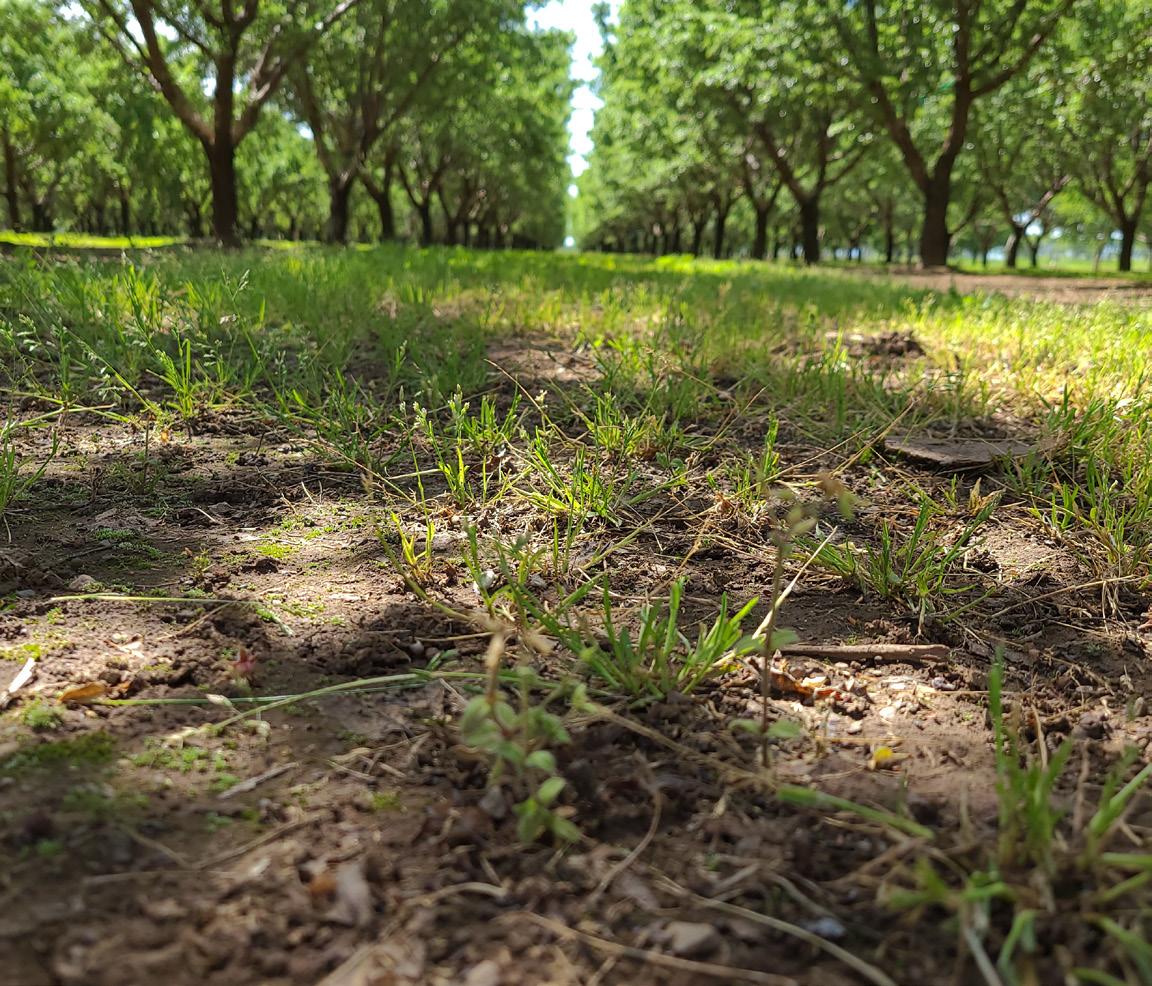 By RICH KREPS | CCA, SSp., Contributing Writer
By RICH KREPS | CCA, SSp., Contributing Writer
Biology is soil health. Period.
Over the last 10 years, I have had multiple conversations with farmers that have used the statement, “I don’t really believe in all the biology talk.” Okay “flat earthers,” I have news for you: If you don’t believe in the importance of having a flourishing, active and balanced soil biology and its direct impact on your crop’s health, you
need to do some reading this winter. Think about the biology in your gut. A flourishing active gut contains 5 pounds of biology in it. 5 pounds! That’s the same weight as your liver, and that’s a significant organ. Well, the soil is even more dynamic than that. There are, give or take, 50 billion biological organisms in a tablespoon of soil. Let that sink in. They don’t just hang out. That system
has been perfected over billions of years.
Your gut is kept at a perfect 98.6 degrees F most of the time. The moisture remains fairly constant as well. There is a steady food supply being introduced all the time. It harbors the perfect environment for biology to grow. If things
ContinuedonPage16
14 West Coast Nut October 2023
Soil health starts with effective plant biology and this can actually be tested in the soil (photo by T. Chalstrom.)


get out of whack, we take antibiotics to kill the bad stuff. Unfortunately, it also kills the good stuff. It takes a long time to rebalance that biology. It takes even longer if you’re not eating prebiotic and probiotic foods as well. Cultured and fermented foods will help speed that up. Taking probiotics as a supplement will speed it up as well. Your soil doesn’t have the same luxury.
Think of your soil the same way. Mother Nature wants balance. We tend to manipulate that with monocropping, long irrigation sets followed by longer dry-down periods, synthetic fertilizers, herbicides, fungicides, insecticides, tillage and soil amendments. It’s very hard to reach a balanced homeostasis with all those inputs. Full disclosure: I sell products with active biology in them. That means we brew our own products that have been proven to have beneficial responses in soil and on foliage for

nutrient use efficiency. There are lots of products out there that are the byproducts of an active biological process or fermentation. They have benefits too. In my years with Ultra Gro, I have seen orchards, vineyards and row crops turned around with sufficient applications of beneficial, active biology. I have applied biology with minimal results as well because those strains of biology may have already been sufficient, while other cultures were needed for the remediation to happen. Test it and do your homework.
The relationship between soil biology and our plants is complex. Root exudates create a beneficial environment for specific biology that the plant has deemed a good fit. That biology ingests nutrients and transforms them into an available nutrient the plant can then use. Our guts are signaled the same way. The brain likes specific responses that promote the growth of certain bacteria. Too much of an anti-nutrient or specific macro and we get out of whack.
The bad takes over and we get sick. Between aerobic and anaerobic bacteria, the same thing happens in the soil. Fungal pathogens and mycorrhizae follow similar patterns. Good food and environment can enhance the proliferation of good biology. There are strains of biology that are assimilated into the plants for this same exact reason. Some biology may not transform a specific nutrient, but the immediate acidity it creates makes that nutrient more available. We have tested soil before and after foliar applications that create a root flush and increase exudate levels in the soil within days. The system is diverse, complicated and powerful. Biology makes that happen. Studies have shown native mycorrhizae creates a much larger net for nutrients to be absorbed, and a symbiotic relationship is created with the roots. Ectomycorrhizae and endomycorrhizae live around and in roots. Studies have shown forests thrive because these superhighways in the ground allow nutrient
ContinuedfromPage14 16 West Coast Nut October 2023
movement between larger trees and young trees (those that can’t photosynthesize well in the shade) to keep the “babies” flourishing.
What to Do?
Now for the solution to the solutions. Test your soil. There are meters that measure the fungal to bacteria levels in your soil within 20 minutes. have hired labs to test the CO2 off-gassing of soil to measure how active biology is in the soil. There are plant pathology labs out there that will plate and test your soil to measure the actual biology present (or not). Others in our industry have contracted genomicists to map the biology in products and plants to see which are the beneficial strains and which can be detrimental. Pick a company or two you trust and start inoculating your soil with beneficial biologicals. I’ve heard rumor that we may be up to 6000 identified strains out of potentially millions. We are just scratching the surface. You can even tailor your choices to the nutrients that match the demand curves your trees are needing. Nitrogen-fixing bacteria early in the season when N
demand is high. Pseudomonas in early spring when cold, wet temperatures aren’t allowing proper phosphorus fertilization. Actinomycetes when you’re trying to get minor nutrients into the trees. Add carbon and carbohydrate solutions to feed the soil biology several times a year, not just in spring, to keep a constant supply of food in the ground. Don’t forget our trees are 95% carbon, hydrogen and oxygen. Making those three nutrients abundant and available to both biology and the trees can help make a healthy soil.
Don’t overlook your soil health. There is more than meets the eye in making every bit of that nutrition you apply work. After fungicides, insec-






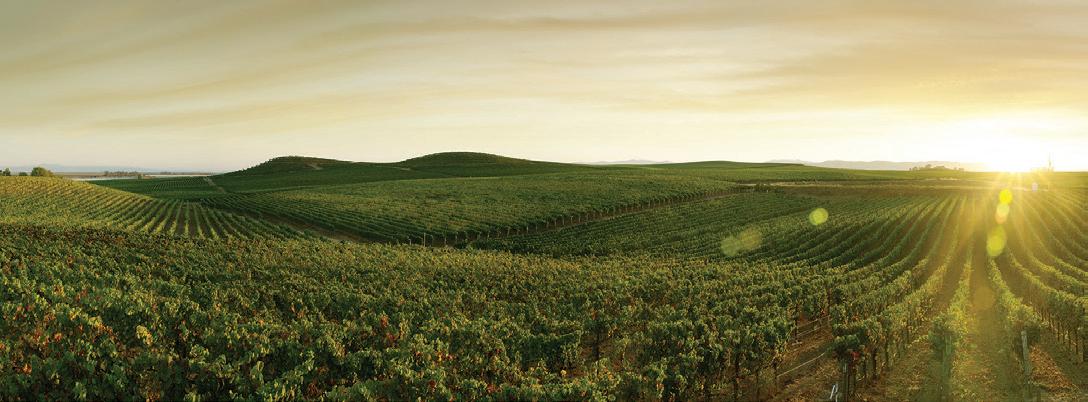
ticides and herbicides, reinoculate your soil. Use different products from different companies to keep a variety of beneficial strains active. There isn’t one company out there that has all the answers to every problem in making soil and plant biology as effective as it can be. However, inert soil will not produce optimal yields, period. Keep that soil active and you’ll have greater success in your nutrient use efficiency. Money well spent will be money well earned.


Comments about this article? We want to hear from you. Feel free to email us at article@jcsmarketinginc.com

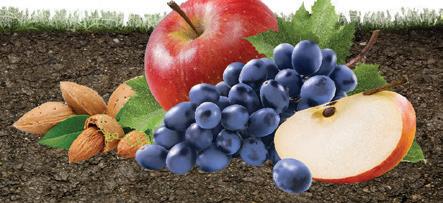
400 S 200 E, EMERY, UT 84522 | (435) 286-2222 | (800) 846-2817 CALL ERNIE AT (661) 304-2676 APPLY HUMATE WITH YOUR POST-HARVEST SOIL AMENDMENTS
’ October 2023 www.wcngg.com 17
Good food and environment can enhance the proliferation of good biology. There are strains of biology that are assimilated into the plants for this same exact reason.
Alternatives to Fumigation in Almonds: Rice Bran Applications and ASD
 By ALMOND BOARD OF CALIFORNIA | Contributing Writer
By ALMOND BOARD OF CALIFORNIA | Contributing Writer
which is why ABC has actively invested in research to help provide answers to growers.
In one study led by Browne, 25 soil samples were taken throughout the Central Valley, and a bioassay was conducted to assess the severity of PRD. Their findings showed no correlation between the disease’s severity and phytopathogenic nematode counts, but they did discover certain regions of California with a higher soil pH can be more susceptible to PRD.
The focus of this study, however, was to assess the microbial root population in the soil to determine if certain microbes indicate a problem.
Soil fumigation is a practice that has been used for ages to control soilborne pests and mitigate destructive diseases. However, with raised input costs, increased chemical regulation in California and a larger market-based push for using more sustainable options, finding alternatives to fumigation is an important focus being explored by industry experts and the Almond Board of California (ABC).
Growers want to ensure these alternatives are as impactful as fumigation, especially in eliminating the possible threats to their crop. And so, the challenge lies in ensuring these adopted practices are effective and economically feasible for the grower.
For example, prunus replant disease (PRD), a soilborne disease that affects various plants in the Prunus genus and manifests when you plant a new prunus
species after you remove a prunus species on the same soil, is one of those threats believed to only be treated by fumigation. This disease causes growth stunting and yield reduction in the very early life of an orchard, and it tends to dissipate with the years of life of an orchard. Various soil types and rootstocks are factors that can influence the disease’s severity.
Though it does vary by soil type, growers can typically cut the severity of the problem by about half with each year of fallow, said Greg Browne, research plant pathologist at USDA-ARS. However, intentionally fallowing land is obviously a complicated strategy from a grower’s financial point of view.
Diagnosing PRD
Because of this disease’s variation, diagnosing PRD can be challenging,
“We found shifts in the communities, but no specific targets in the soil that you could detect and use as an indicator in roots,” Browne said. “What it did is focus our attention on elements of the microbial community in bacterial domain.”
Anaerobic Soil Disinfestation as a Solution
While fumigation is traditionally the most effective form of management for PRD, holistically, it is not the best approach.
“For many reasons, economic, environmental and so on, we really need to be looking at alternatives to fumigation in the long run,” Browne said.
ABC is investing in research to examine alternatives, and one of the most successful methods looked at is known as anaerobic soil disinfestation (ASD).
A
ContinuedonPage20
WORD FROM THE BOARD: THE ALMOND BOARD OF CALIFORNIA
18 West Coast Nut October 2023
A row of almond trees replanted with a rice bran substate as an alternative to fumigation. This trial is part of the fumigation alternative research at the Kearney Ag Research and Education Center in Parlier, Calif. by Dr. Greg Browne (all photos courtesy Almond Board of California.)
Bins, Harvest Equipment Can Spread the Pistachio Pest Gill’s Mealybug

Pressure washing of pistachio harvest equipment and bins as well as any other equipment used in pistachio orchards is recommended to slow the spread of Gill’s mealybug to new orchards in northern growing areas.
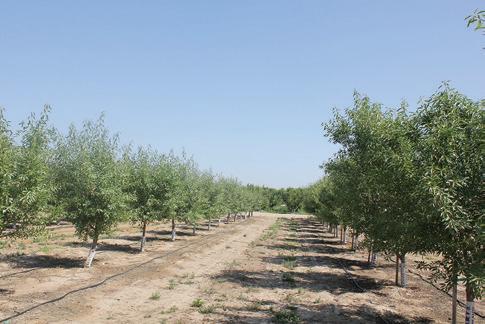
Sequential Herbicide Applications Are an Option in Orchard Weed Control
Broad-spectrum herbicides glyphosate and glufosinate have been the go-to tool in orchard weed control because of their e cacy; glufosinate covers the glyphosate short comings which include resistance. At the Almond Board of California Soil Pest and Weed Management Summit, UCCE Orchard Systems Advisor Phoebe Gordon explained...
Mitigation is Key for Prunus Replant Disease
Growth-stunting Prunus replant disease has the potential to rob a large chunk of early almond yield if action is not taken prior to planting.
Prunus replant disease (PRD) is a speci c soilborne, microbe-induced suppression of early tree growth and yields.

October 2023 www.wcngg.com 19 TOP ARTICLES FROM PREVIOUS ISSUES IN CASE YOU MISSED IT To subscribe scan the QR code or visit myaglife.com/subscribe Don’t miss a single article Subscribe Today receive them directly to your inbox Exclusive Articles Twice a Month
The process consists of adding a carbon substrate to the soil, covering it with a tarp and maintaining soil moisture at field capacity for four to eight weeks.
There is a diverse list of carbon substrates that can be used, but in phase one of the trials conducted by Browne in part with ABC, rice bran was first evaluated. The researchers used an auxiliary drip system to sustain water levels, and a TIF tarp was utilized.
The outcomes showed a reassuring shift in microbials that suppress nematodes, other pathogens and microbials that cause PRD. Tree yields using either preplant soil fumigation or ASD also more than doubled on orchards affected by PRD, proving its ability to be as effective as fumigation.
The caveats growers will find with this type of treatment are cost and practicality of implementation. Using ASD, one acre is estimated at $2,000+, while soil fumigation is estimated at $820 per acre. Rice bran is also not widely available in California.
Because of this, a second trial was conducted, this time using a different carbon substrate that would likely be less expensive without comprising fertility.
“We have tested quite a range of substrates for driving

ASD,” Browne said. “We went to focusing on two that we felt had the most potential: rice bran and ground-up almond hull and shell.”
Browne said they also assessed if water moisture and a tarp were necessary to get the same results and how to incorporate mechanization so it could be performed on a larger scale.
After multiple trials with the two substrates, the researchers concluded that when compared to almond hulls and shells, rice bran resulted in more consistent growth and yield.
Almond hull and shell are still a powerful option when applying ASD, though the one downfall is it is not strong enough to be just an amendment alone.
“We found when we took the process apart that much of the rice bran benefit occurred even without water and tarp,” Browne said. “There’s a lot of benefit from just the rice bran as an amendment alone.”
Cost was also another factor analyzed in their trial. The researchers treated row strips that constituted half the orchard area, which showed that alternatives to fumigation can vary but are generally more expensive than a fumigation treatment.
So, what does this mean for tree growth? Browne said in their most recent trials, rice bran not only proved to be an asset in making ASD a viable substitute, but it also benefited tree growth.
“We really didn’t achieve anything with water and tarp treatments alone, but when we add rice bran amendment alone, we got a big increase in tree growth,” Browne said. “If we did the full rice bran and tarp ASD, we got another incre-
Control = $0/ac
Control + Water + Tarp = $445/ac
Rice Bran (9 tons to treated acre) = $1,392/ac
Rice Bran (9 tons to treated acre)
+Water + Tarp = $2,187/ac
Almond Hull/Shell (9 tons to treated acre) = $1,212/ac
Almond Hull/Shell (9 tons to treated acre) + Water + Tarp = $2,007
Positive Control Stand of Fumigation with 1,3-D/Chloropicrin = $1,772/ac
ContinuedfromPage18
20 West Coast Nut October 2023
Costs for alternatives to fumigation can vary but are generally more expensive than a fumigation treatment
ment of improvement, even better than the jump that we got from preplant fumigation.”
On the other hand, ground almond hull and shell was not as successful, though still comparable to fumigant levels.
Simultaneously, they also conducted three fertilization treatments within these test plots: standard nitrogen, a high-end nitrogen and standard nitrogen and phosphorus.
“The nest fertilization treatments were not as impactful as the effective ASD or fumigation treatments, but you do see that we got a significant response to phosphorus,” Browne said.
Browne noted continued refinement is needed of these amendment-based approaches, and ABC continues to invest in research to provide growers with the best resources and strategies.
“In my view, the work in this area is a prime example of how long-term commitment and vision in the research method bring solutions to practical
challenges that are particular to our almond growers,” added Sebastian Saa, associate director of agricultural research at ABC.
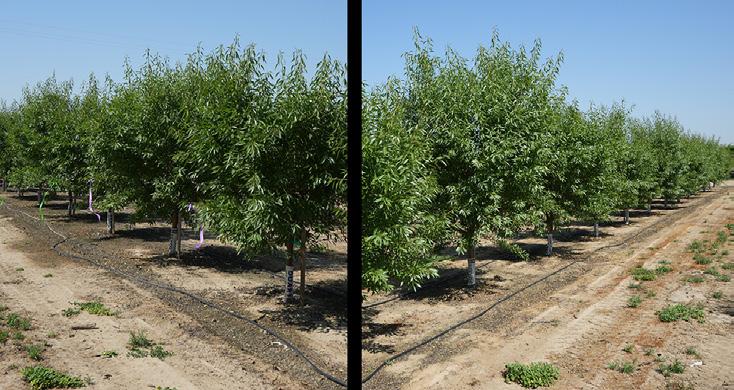
“As we move ahead and get to implementing some of these experimental strategies for management of the soil, we’re going to have to think about substrate supplies, transport issues for
these substrates and how plentiful and widely available they’re going to be,” Browne concluded.
Comments about this article? We want to hear from you. Feel free to email us at article@jcsmarketinginc.com

October 2023 www.wcngg.com 21
A row of almond trees with rice bran added at planting (left) compared to a row of almond trees with standard fumigation at planting (right).
Remembering Bill Tos Tree Nut Grower’s Legacy will Leave Lasting Impact on Industry
By LORI FAIRCHILD | Contributing Writer
The tree nut industry lost one of its biggest champions at the end of June with the death of Tos Farms’ Bill Tos, but the legacy he leaves behind will continue to impact the industry for years to come.

From his involvement with the California Walnut Board (CWB) to his interest in research to his love for
farming, Tos left a lasting impression on both the people and the direction of the tree nut industry. Tos was one of the largest walnut growers in the state of California, but those who knew him say his legacy goes far beyond that.
“His legacy in the walnut industry is going to be his leadership, his involvement and the direction of the walnut
industry,” said Gary Ford, executive chairman of Diamond Foods. “From being on the board to serving on various committees over the last 30 years, Bill’s legacy is with his positive involvement in every aspect of the
ContinuedonPage24
22 West Coast Nut October 2023
Industry leader Bill Tos’ love for his family was apparent to all who met him.










walnut industry from marketing to cultural practices to seeking help from our elected officials.”
Tos served in a variety of positions on the Walnut Board over the past 30 years, most recently as chairman of the executive committee. He also served on the Board of Directors of Diamond Walnuts and the Diamond Walnut Grower Advisory Committee and was president of the Sequoia Walnut Grower Association.
“Bill Tos served the California walnut industry as an elected leader for over 30 years in numerous volunteer roles on the California Walnut Board and Commission Board of Directors, committees and working groups,” said Robert Verloop, CWB executive director. “Bill was a growers’ representative as well as handler representative for Diamond Foods. Regardless of his position, Bill was an advocate for all growers and wore an industry hat when he came to the table.”
Tos was a third-generation farmer growing walnuts and almonds at Tos Farms, the family business founded in 1912. He joined his father, uncle and brother as part of the business in 1981, and his love for the job was well-known.
“When we walked in his family walnut orchards, his love for farming was front and center,” Verloop said. “He talked about the beauty and serenity of his well-groomed orchard and how he enjoyed watching the season progress from bare limbs in the winter until the late summer harvest.”
Although his family had a rich history in the tree nut industry, he wasn’t afraid of change, throwing his support behind industry research.
“Bill was known to look out for the industry’s best interest, especially when it came to the importance of production research,” Verloop said. “With pride, he showed me his plantings of new varieties, the result of the Walnut Improvement Program, for which he was a vigorous proponent.”
Former CWB Research Director
Dave Ramos credits Tos with being a key player in setting the long-range direction of the Walnut Improvement Program.
“He was responsible for the industry’s approval for launching a five-year strategic plan in 2013 to advance walnut genomics and bring marker-assisted breeding to full application in the breeding program,” Ramos said. “He also made the motion that resulted in doubling the walnut breeding program endowment to bring it up to $2 million [now valued at over $3.6 million].”
Tos also served as chair of the CWB’s Production Research Committee where he was responsible for oversight of grower investments in research.
“He approached proposals with healthy skepticism and asked incisive questions but was always supportive and open to useful new ideas, had a wide vision in support of immediate problems, and kept his eyes over the horizon to support long-term projects directed to the future health of the industry,” said Pat J. Brown and Chuck Leslie of the UC Davis Walnut Improvement Program.
Never the loudest person in the room, Tos was a quiet leader, nearly always listening to everyone else before he let his opinions on a topic be known.
“Bill had a quiet approach during meetings, listening to both sides of an issue, but when the time required it, he would calmly share with others his
well-thought-out position,” Verloop said.
Ford’s experience working with Tos was similar.
“He was a great listener,” Ford said. “He did not ask a lot of questions, but when Bill asked a question, it was always relevant and a question that should have been asked. He was a thoughtful, driven, results-oriented businessperson who cared deeply about people.”
But just because Tos was a listener didn’t mean he didn’t have things to say.
“From the first day, Bill struck me as a straightforward person,” said Andreas Westphal, UC ANR Extension nematologist. “In his various roles within the California Walnut Board, he always impressed me with his well-thought-through comments and questions.”
Tos also wasn’t afraid to speak the truth, even it if wasn’t what the person he was speaking with wanted to hear.
“My relationship with Bill was very valuable to me,” Ford said. “I knew I was going to get the absolute truth from Bill. Bill was never going to tell me what I wanted to hear. He was always going to tell me what I needed to hear.”
While Tos loved farming, he also invested heavily in relationships with those both inside and outside the industry.
“He was a very people-oriented businessperson,” Ford said. “He spent most
ContinuedfromPage22
“...When Bill asked a question, it was always relevant and a question that should have been asked. He was a thoughtful, driven, results-oriented businessperson who cared deeply about people.”
24 West Coast Nut October 2023
– Gary Ford, Diamond Foods
of the past 25 years actively involved in the Walnut Board, primarily as a board member. He took many trips to Washington to meet with our elected officials and was very good at that. He knew how to form relationships with people working on his ranch and how to do the same with people who were in Washington working for us. It’s not easy for people to be as diversified in their relationships as he was.”
And Tos’ love of his family and community came through to everyone he met. He and his wife Linda were married for 42 years, and they had three children and five grandchildren.
“Most of my relationship with Bill has been work-related and walnut-related,” Ford said. “Outside of the business, outside of farming, Bill’s faith and his family always came first. That was clear. He was a good man. I don’t know that I’ve ever heard anyone say
anything negative about Bill Tos. He was very well-respected not just within the walnut industry but also within the Hanford, Calif. community.”
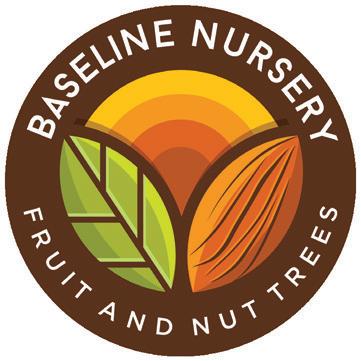
When it came to giving back to the community, Tos was involved with the Education and Agriculture Together Foundation where he could share his knowledge and love of agriculture with teachers who would then take that information back to their classrooms to help students understand the importance of agriculture in their lives. He was also active on the boards of Hanford Christian School and Central Valley Christian School in an effort to make a Christian education available to more students.
Whether he was running his business, advocating for the industry or serving on a board or committee, Tos’ quiet presence will be missed.
“I will always remember Bill as an
exceptional person. I appreciated his Christian values, his intelligence and humility and wonderful personality that always made me feel so good just to be with him,” said Robert Lea, long-time Diamond Foods and Walnut Board member.

And Tos’ impact on the industry will not be forgotten.
“He was always available to share the history of a topic, presenting insights and options. His counsel was invaluable in my first year,” Verloop said. “We will miss Bill’s participation, contributions and warm demeanor. His imprint on the industry, however, will remain.”
From Lab to Field Partnering with the best to provide quality trees and service WALNUTS VX211 RX1 Vlach Grafted PISTACHIO UCB-1 ALMONDS Nonpareil Monterey Butte Padre CONTACT US TODAY 916-605-0463 sales@baselinenursery.com 3556 Sankey Rd. Pleasant Grove, CA 95668 Comments about this article? We want to hear from you. Feel free to email us at article@jcsmarketinginc.com October 2023 www.wcngg.com 25
View from the Top Jim Zion Is Betting on Pistachios
 By CATHERINE MERLO | Contributing Writer
By CATHERINE MERLO | Contributing Writer
If anyone has an inside view of California’s tree-nut industry, it’s Jim Zion.
Zion is the managing partner of Meridian Growers, a growing and processing company that sells some 25 million pounds of dried fruits and nuts to 40 countries each year.
He’s been involved with California agriculture, particularly pistachios, for more than 20 years. Earlier in his career, he worked as an agricultural appraiser with Security Pacific Bank. He later managed the California Agricultural Export Program for the California Department of Food and Agriculture.
Today, he’s vice chairman on the board of directors of American Pistachio Growers. He’s also on the board of the Specialty Crop Trade Council, which negotiates ocean freight rates on behalf of the industry.
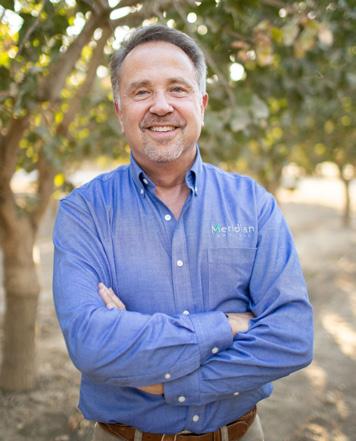
Meridian Growers processes its pistachios at its plant, built in 2021, near Firebaugh, Calif. Zion and his team are already increasing its capacity, which will expand Meridian Growers’ pistachio volume to 50 million pounds this year.

Almonds from Meridian Growers’ orchards head to Minturn Nut Company for processing. Its pecans are han-

The Meridian Growers owner believes in the green nut’s value-added possibilities, but he still has faith in almonds.
Jim Zion of Meridian Growers expects prices to level out for almonds as supply comes into balance (all photos courtesy Meridian Growers.)
Built in 2021, Meridian Growers’ pistachio processing plant between Firebaugh and Madera has already undergone an expansion.
26 West Coast Nut October 2023
Pistachios are loaded into boxes for export shipment.
dled by Texas-based Southern Roots Nut Company, which Meridian recently joined, partly because Zion likes its cooperative pooling mode.
Zion’s experiences give him unique insight into both domestic and international markets. They’ve earned him a few battle scars too, including “gray hair and ulcers” brought about, he said, by the supply-chain disruptions that wracked California ag exporters when the COVID-19 pandemic hit in 2020.
In late August, he discussed his views with West Coast Nut on the challenges and opportunities for California pistachios and almonds.

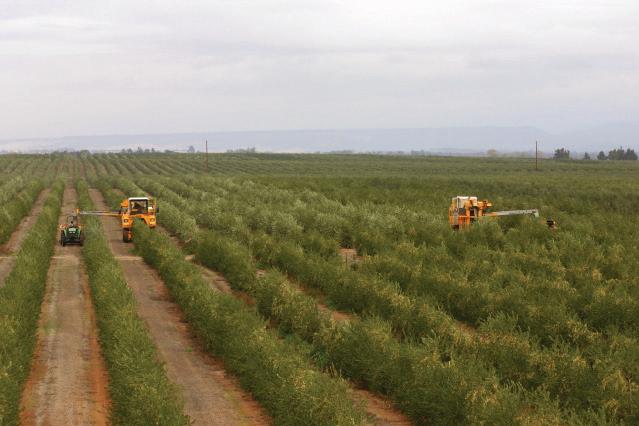
Q. What’s the pistachio market looking like?
Pistachios remain a strong market, with good demand for new crop coming out of China and, to a certain point, India. We expect European buyers to come back into the marketplace in early September. We’re seeing some demand out of Canada. Our domestic markets have been stable. I’m happy with what we’re seeing so far.
Q. What are ballpark prices for pistachios right now (late August)?
Even though it’s a larger crop this year, we have a very minimal carry-in from last year. A lot of the crop was sold or has been committed, so pistachios are a pretty stable marketplace. On the bulk wholesale level, prices are about $3.65 a pound for in-shell #21, which is the Chevrolet or standard of pistachios. In terms of the commodities that we work with, pistachios are still doing well.
Q. What’s your view of the almond market?
There’s the large carryover from last year, which has depressed the market. The official estimate for this year’s crop is 2.6 billion pounds, but most growers don’t think it’s going to reach that. In our own orchards, we’re down 25% from last year, and we were down the year previously. But we’ve recently seen the market start to move again, mainly on strong demand coming out of India for in-shell. We’re getting more inquiries from Southeast Asia. What I’ve found is when almond prices go
down, people start looking to buy more. When that happens, we see demand go up as people look at incorporating almonds more. So, I do think we’re going to see prices level out and start to move up, especially if the crop ends up being less than 2.6 billion.
Q. Are you pulling out almond trees?
No. We like to be multi-faceted, never a single commodity, because you
never know what’s going to happen. It’s rare that all the commodities move up or down at the same rate. Plus, for marketing, it’s better for us because we can go to a customer and have multiple products for them. Some of the small to mid-sized customers like to make one phone call to inquire about almonds, pistachios and other products.
Cliff Beumel 530-531-7086 cbeumel@agromillora.com Main Office 530-846-0404 www.agromillora.com SUPER HIGH DENSITY OLIVES FOR OIL Your Best Orchard Crop for the Future! California Nursery Gridley, CA -OLIVE OIL PRICES AT ALL TIME HIGH -FASTER ROI -GROWN, MILLED AND SOLD IN US -HIGHEST PROFIT IN ORCHARD CROPS -100% MECHANIZED FROM THE MOMENT OF PLANTING OLIVES REQUIRE THE WATER OF ALMONDS AND ¼ THE NITROGEN TO PRODUCE A FULL CROP ContinuedonPage28 October 2023 www.wcngg.com 27
Q. What’s the solution for the burdensome supply of almonds?
Almonds are going to be self-regulating. Orchards are coming out.

Some are the older orchards that aren’t efficient, and some are the younger ones that may not have adequate water. The cost of production has gotten so high. So, you’ll see the supply situation start to move down, and then you’ll see prices come up. You may see some
additional plantings, but there will be a limit. With interest rates approaching 10%, development costs are pretty high. Unless you have a decent return back, which almonds don’t at this point, I don’t see a big rush to plant trees.
I just hope we don’t get into an under-supply situation and not have enough product because the last thing we want is not to have an adequate supply to keep this demand going.
Q. What are your biggest challenges?
The biggest issue in California is water. We know SGMA (Sustainable Groundwater Management Act) is going to be implemented. A lot of growers know there will be a reduction in water, but they’re not sure how it’s going to affect them. Most everybody is looking to make sure they have at least two sources of water.
Beyond the water situation, it’s the rules and regulations we have to follow in California. Every year, they get more onerous. On the processing side, we expect minimum wages to go up. We’re hearing rumors they may increase to
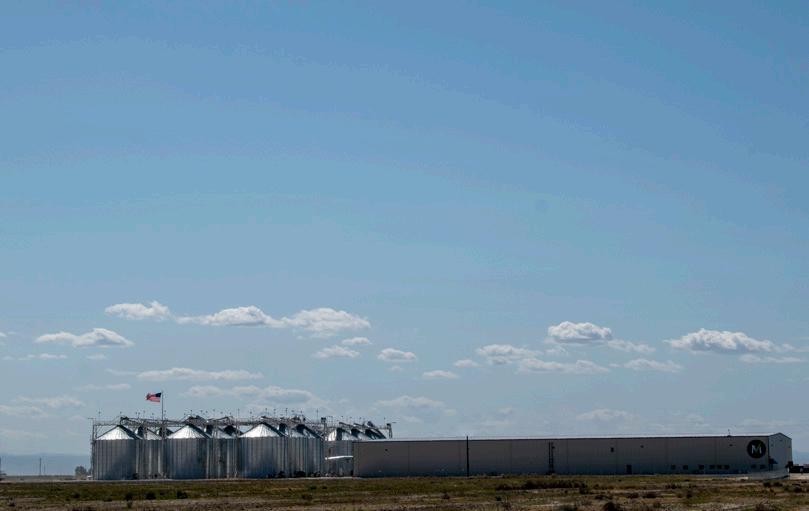
ContinuedfromPage27
Building demand is key for the pistachio industry to get ahead of the 2-billion-pound crop that’s coming, said Zion.
“
”
Even though it’s a larger crop this year, we have a very minimal carry-in from last year. A lot of the crop was sold or has been committed, so pistachios are a pretty stable marketplace.
– Jim Zion, Meridian Growers
28 West Coast Nut October 2023
Rising labor costs are pushing Meridian Growers to seek more plant automation.
$25 an hour. The cost of labor is getting more expensive. So, anything we can do to become more efficient or automated, we’re going to do. That’s just a fact of life for us to survive.
Q. What are your thoughts on the heavy pistachio production expected in the next couple of years?


The increased plantings we saw four, five, six years ago will start coming in. So, we know the 2-billion-pound crop is coming. A lot of effort in the industry, both generic and branded, is toward building demand ahead of supply. It’s getting consumers to realize that pistachios are a healthy part of their diet, one of the only nuts that are 100% protein. It has all 13 amino acids. The more we push that health message, the more it will help.
In addition, we’re looking at other uses for pistachios. Most people still eat them as a snack with the shell on them. But you’re seeing more and more people use pistachios as an ingredient. More restaurants are incorporating pistachios. We went to a restaurant the other day and had a caprese salad that had pistachios all around it. That’s how we can move that demand-curve up. Our goal is to always pull that demand ahead of supply so we’re not surprised.
Q. What’s ahead in the export market?
The big market for many years was China because of its population and growth. But we are seeing changes in China. Their economy is slowing down, unemployment is going up and interest rates are rising. We don’t have the best trade relations with China, and I don’t see that getting any better in the near future. I hope we can maintain the status quo because Chinese consumers like dried fruits and nuts.
The next one coming up is India, the most populous country in the world. They’ve got a burgeoning middle class that’s expanding rapidly. Nuts are a very important part of their diet. India is going to be one of the most important markets for pistachios. It already is for almonds. Europe is a more mature market, so the growth there is going to have to be on new products. There’s
some interest from Mexico and some pockets of growth we could see in Africa.
Q. What else is Meridian Growers working on?


We’re always looking to improve our processing automation to make things more efficient, to recover more of the product and return more dollars back to the growers. My son, Tyler, is working with me now. He’s starting to work on value-added products. His big project right now is pistachio butter. In Europe, they use pistachios on everything. In Spain, they take pistachio butter and make it into gelato. Pistachio butter is amazing and has a unique color. There’s no other nut out there that’s going to be green. When you make a fresh-ground pistachio butter, the flavor is absolutely amazing. I see value-added as the future for pistachios.
Q. What’s your outlook for this new marketing year?

We’re expecting good crops in Cal-
ifornia on almost everything. So, we’re going to have to work on the marketing side. With the world economy and all the uncertainty, it’s once again getting back to the basics of why a consumer would want to spend that dollar, euro, yen, whatever it is, on that pound or kilo of nuts. What’s the value proposition? That’s highly important. And I think you’re going to see more messaging on farmers as environmentalists. I mean, we’re the original ones. We’ve been doing it for years. We rely on clean soil, water, air, you name it. We have to. The trees we manage are going to become more important as we work toward whatever that goal is on climate change and trying to reduce emissions. California and Arizona agriculture will be a key part of that.
Kraemer & Co. Mfg., Inc. Almonds • Pecans • Pistachios Walnuts Let Kraemer & Co. Design and Build the Facility that is Right for Your Needs Nut Drying & Storage Facilities 3778 County Road 99 W Orland, CA 95963 530-865-7982 │ Fax: 530-865-5091 CA Cont. Lic. #485-547 │ Web: www.kcomfg.com • Burners • Fans • Drying Systems • Storage & Handling • Custom Manufacturing • Spiral E-Z Let Downs • Installation & Service • Knock Down Kit • Modular • Corrugated / Galvanized Construction • Do-It-Yourself Option • Low Lead Time • 6 Ton Capacity Walnut Drying Bins Comments about this article? We want to hear from you. Feel free to email us at article@jcsmarketinginc.com October 2023 www.wcngg.com 29
Putting the Pieces Together When Choosing the Right Rootstock
By CECILIA PARSONS | Associate Editor
Agrower’s decision on what variety of tree nut to plant and which rootstock to use is not always easily made. For one thing, a bad decision can be costly and possibly will have to be lived with for years.
What tree nut growers are seeking is a trouble-free tree that will grow well in the soil at the orchard site, be productive and perhaps hit a harvest window desired by the processor. Growers can seek planting advice from a number of sources, but as Agromillora nurseryman Cliff Beumel notes, “There is no guru out there. Don’t rely on one to tell you what to plant.”
There are rootstocks for almonds, pistachios and walnuts that were developed to tolerate certain soil conditions. Rootstocks of trees planted in sandy soils, heavy clay soils and even salty soils need to have the genetic makeup to overcome these conditions. Rootstocks play an important role in how trees tolerate less than optimal soil conditions and support productive tree nut varieties.

Soil is a key factor in choosing a rootstock and variety combination, Beumel said, but it is not the only one.
He said growers may desire to plant a certain variety to hit a desired harvest window. The soil at the orchard site may not be a perfect match

30 West Coast Nut October 2023
Matching the soil to the variety and rootstock is an important first step for planting new orchards (photo by C. Parsons.)
for the rootstock or the variety grafted on, but the grower is willing to take the risk because their concerns with harvest outweigh the risk of underperforming trees due to soil conditions.
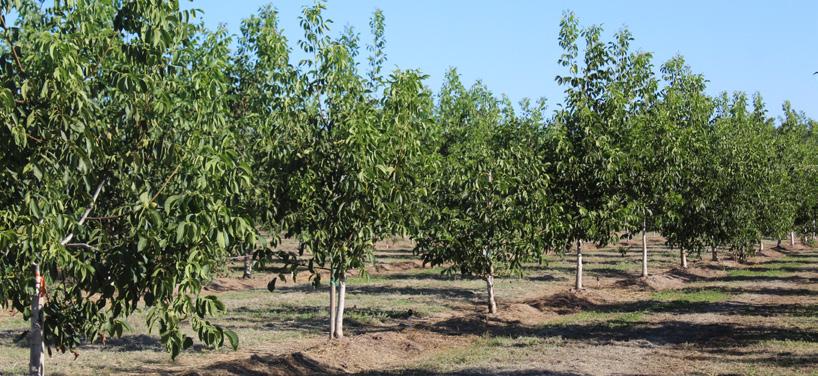


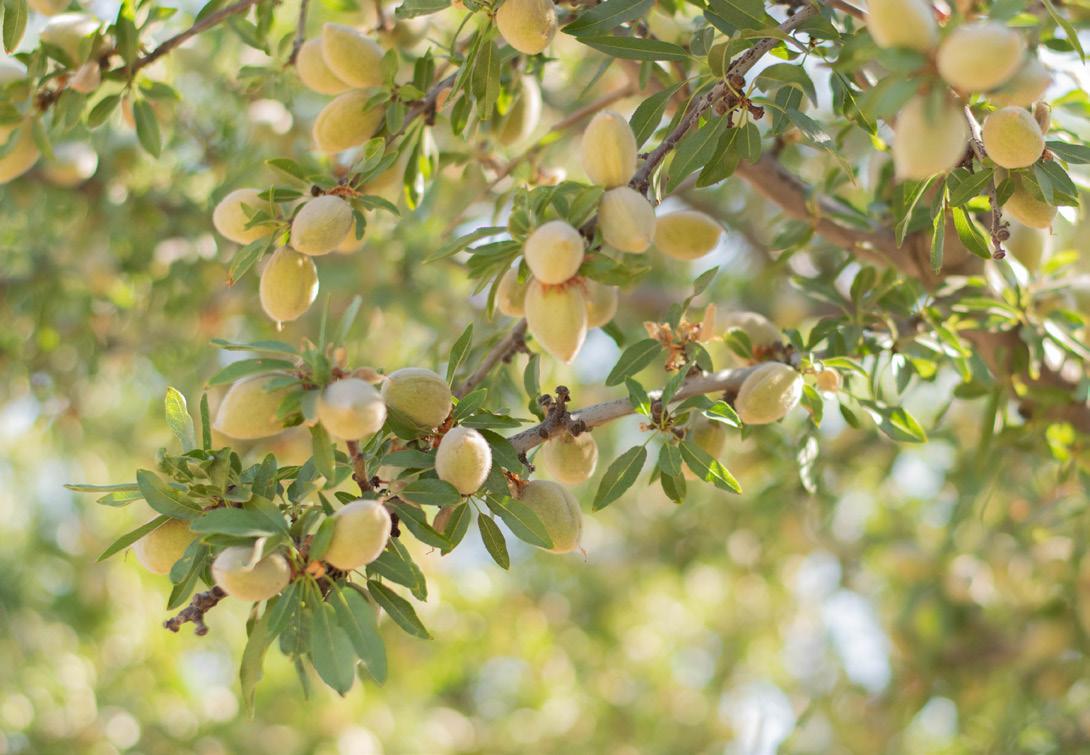
While stressing there is no one
perfect answer or person who can tell you the perfect planting option, Beumel said there are plenty of people who can present growers with the information they can use to make a decision.
“Go to different stakeholders and ask
them for relevant information on varieties and rootstocks. It is never an easy decision, but it should be an informed decision.” ContinuedonPage34
DWNTREES.COM | 1-844-DWN-TREES | @davewilsonnursery FARMER PROVEN SINCE 1938 POTTED AND BARE ROOT TREES AVAILABLE NOW Viking • Atlas • Rootpac R ™ • Hansen • Nemaguard • Lovell HOME OF THE INDUSTRY-LEADING INDEPENDENCE ™ INTRODUCING THE NEW SELF-FERTILE LIBERTY ™ ALMOND Blooms 4-5 Days after Nonpareil • Harvests 10-14 days after Nonpareil
October 2023 www.wcngg.com 31
Site history and previous crops are among non-physical characteristics to be considered prior to planting (photo by K. Platts.)





NOVEMBER 2, 2023 4PM - 8PM JASON SCOTT CEO OF JCS MARKETING, INC. YOU’RE INVITED TO THIS ONCE IN A LIFETIME EVENT JESSE WATTERS CO-HOST OF FOX NEWS KEYNOTE SPEAKER EVENT HOST INTERNATIONAL AGRI-CENTER 4500 S LASPINA ST, TULARE, CA 93274 MYAGLIFE.COM/MYAGNITE SCAN THE QR CODE OR VISIT FOR MORE INFORMATION FEATURING THE CO-HOST OF FOX NEWS JESSE WATTERS SEATING IS LIMITED AND WILL SELL OUT STARTING AT $150 PER PERSON AGENDA MIXER / TRADE SHOW - 4PM - 6PM GOLDEN HARVEST GALA DINNER - 6PM - 7PM KEYNOTE - 7PM - 8PM MIXER AND TRADE SHOW IN THE FARM CREDIT BUILDING GALA DINNER AND KEYNOTE SPEAKER IN THE CORTEVA BUILDING AG MARKETING SOLUTIONS POWERED BY
Fox News Host to Headline My Ag Nite Event in Tulare
Political commentator and Fox News co-host, Jesse Watters, will be the headliner at a premiere ag event coming to the heart of the Central Valley on November 2. My Ag Nite, hosted by Jason Scott, CEO of JCS Marketing, Inc., will bring together industry professionals and conservative dignitaries to celebrate all things California agriculture.
The dinner and gala will take place at the International Agri-Center in Tulare, Calif., and is expected to sell out. Guests will have access to an exclusive trade show showcasing innovative farming solutions, and the opportunity to network and forge connections within the industry.
Scott said he sees the night as a way to bring those who have a stake in agriculture together in one place to celebrate the industry and to wind down and enjoy like-minded solidarity following the stresses of the busy harvest season.
“We’re bringing a diversified group of thought leaders together to celebrate leadership in agriculture,” he said.
Scott is especially excited about the event being able to present a rare, in-person opportunity to hear from a political commentator of Watters’ caliber that will appeal to the conservative farming community. Watters’ notoriety has skyrocketed since he took over for former Fox News commentator, Tucker Carlson, who left the network earlier this year.
The chance to see Watters speak isn’t likely to come around again to this part of the state, Scott said, and
will no doubt make the event memorable.
“We expect this to be one of the best events that we’ve ever put on or will put on,” Scott said. “If you want to attend something that’s different, unique, and special to agriculture, this is the one time you need to make time to show up.”
Scott's firm publishes both print and digital trade magazines. The publications include West Coast Nut, Grape & Wine and Progressive Crop Consultant. Scott's firms also hosts a growing website called MyAgLife, which highlights the diverse agriculture commodities of the West Coast. The site is also home to a daily and weekly podcast highlighting Central Valley ag issues and leaders.
Coming out of a post pandemic reality, Scott came up with the idea for My Ag Nite as a way to stimulate live events, he explained. Like the MyAgLife website and brand, he emphasizes the event being about agriculture as a whole, and not focusing on any one commodity.
“We wanted to do something unique in the industry, for the industry, and we wanted to provide something for the MyAgLife brand,” he said. “The idea behind it is that we celebrate agriculture and our conservative values in the industry.”
Scott says that while he tends to leave politics out of his publications and marketing, he sees My Ag Nite as a way for those who have a stake in agriculture to be able to talk about the issues that affect them first hand—with

the successes and failures of those issues so often being determined by politics.

“I feel like agriculture is in a place where it’s time to get back to basics, it’s time to celebrate a lot of the things we have in common, and be able to come together and talk about it for an evening,” he said.
Scott added that he wants people to walk away with renewed relationships, a better understanding of who ag is as an industry, and the challenges ag faces collectively, as a group.
“I hope attendees will walk away with a sense that not all is lost with conservative values and we don’t stand alone in that community,” he said
Tickets for My Ag Nite start at $150 per person and a number of upgraded ticket opportunities are also available, including a meet and greet with Watters, group table reservations, and trade show booth space. Tickets and further information can be obtained through www.myaglife.com/myagnite. Ag media inquiries only can be directed to the JCS Marketing Office (559) 352-4456. No outside media outlets beyond agriculture.
About JCS Marketing:
JCS Marketing has a rich history in providing marketing services tailored to the agricultural industry. With a deep understanding of the unique needs and values of the ag community, they are committed to fostering connections and driving success within the industry.
Stakeholder Network
This network of stakeholders can include CCAs, UCCE farm advisors, processors, industry leaders and other trusted growers. It can also include the nursery where the trees are purchased, but Beumel is quick to say while nurseries make the plants, nursery operators are not there for planting advice. They can provide trial data on varieties and rootstocks, he said, but are not licensed to give planting advice.
There are physical properties and environmental conditions at an orchard site that should be given consideration when making planting decisions. Tom Burchell of Burchell Nursery in Oakdale, Calif. said soil type, topography, water source as well as adjacent property crops should all be included in the evaluation process. While production of a certain variety may be the growers’ goal, choosing the right rootstock for the site will make the goal easier to achieve.
“We know that peach-almond rootstocks work in lighter, sandy soils and as a general rule, the more complex rootstocks with plum work better in heavy soils,” Burchell said.

Other physical properties include nematode species present and their levels in the soil as well as soil diseases present like verticillium. Burchell said if this is a replant situation, and the site has been farmed for successive generations of trees, a change in rootstock is important.
“Never go back with the same. Nutrients in the soil are depleted, and even with added organic matter, a change in rootstock with more vigor will help with orchard health,” Burchell said.

Physical Limitations
Ignoring the physical limitations of the soil will make healthy tree growth and productivity difficult or impossible to achieve. Deep ripping and fumigation are mitigation measures that can help but may not overcome poor choices in rootstocks.
Other physical conditions in the soil that would affect a rootstock decision include soil chemistries (pH, alkalinity
ContinuedfromPage31 34 West Coast Nut October 2023
and sodicity). A soil sample can also reveal deficiencies or excessive levels of certain minerals. Topography is another consideration, Beumel said. Swales or low areas mean drainage can be affected. Does the site have a history of rainwater percolating through the soil profile or does it run into drainage ditches away from the orchard site, he asked?
John Post, president of Agricultural Advisors Inc. in Live Oak, Calif., suggests doing some digging at the orchard site before making a rootstock or variety choice to determine if soil layers will be barriers to drainage or root growth. The best sites for an orchard have minimal layering or barriers to drainage. Depth of the soil layer can determine if better anchorage in the rootstock is necessary. Depth of the water table is another consideration. Rootstocks that cannot tolerate ‘wet feet’ won’t work.
“Backhoe pits are an inexpensive way to see what is beneath the surface,” he said. Doing a soil survey and looking at the soil profile can give indications of barriers to healthy tree production. It is important to evaluate soil structure and texture to determine a good match for a rootstock.
Beumel noted in other tree nut producing countries like Australia, the practice of digging a backhoe pit every two or three acres and deeply analyzing the soil for all these attributes above is very common, even in very large orchard developments. In California, such careful examination at such an intense level of rigor is much less common in his experience, he added. In Australia, for example, he believes that level of analysis is mandated by law.
When planting almonds or walnuts, Post said the history of the site and the previous crops growth there could influence rootstock choices. Replanting almonds after almonds or walnuts after walnuts means soil evaluation for parasitic nematodes and fungi is necessary. If trees in the previous orchard were unhealthy or dying, it is also good to determine why when evaluating new rootstocks, Post said. Soil fumigation may be necessary before replanting and choosing a tolerant rootstock such as VX211 is necessary.
With almonds, he said there are many more choices in rootstocks with different parentages. The range of genetic differences can help overcome specific issues in the soil. The range of varieties can determine tree size and orchard spacing.
UCCE advisor Franz Niederholzer said he tries not to advise growers on what to plant as there is too much riding on the decision.
“I may tell them what I would do, under certain circumstances, but there is too much riding on such a decision,” Niederholzer said. He suggested growers refer to a beta site that can provide information on rootstocks: fruitsandnuts.ucdavis.edu/rootstocks.
Comments about this article? We want to hear from you. Feel free to email us at article@jcsmarketinginc.com
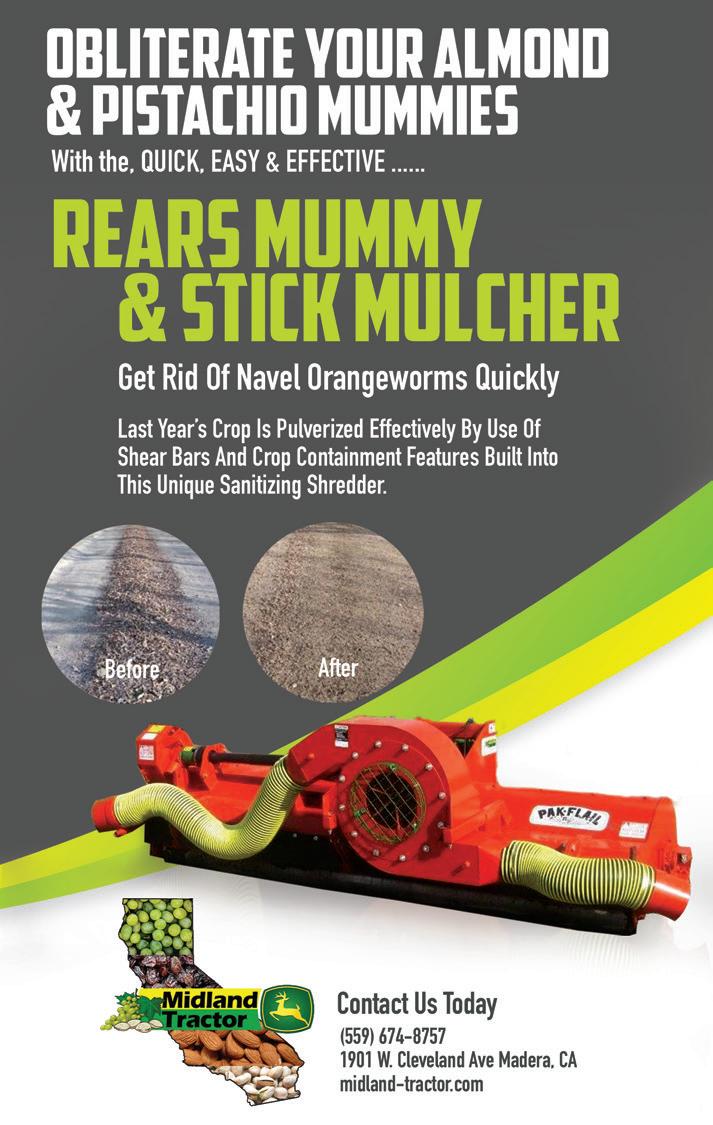
October 2023 www.wcngg.com 35
‘A Lot Has Changed’ Third-Party Firm Evaluates Almond Board’s Marketing Efforts in Post-Pandemic World
 By VICKY BOYD | Contributing Writer
By VICKY BOYD | Contributing Writer

The COVID-19 pandemic caused upheaval on several fronts, including retail markets, consumer preferences and consumer shopping patterns, and many will never return to pre-pandemic days. To get a better handle on today’s marketplace and consumers, the Almond Board of
California commissioned a third-party consulting firm to evaluate its current programs and provide information it can use to strategically position almonds during the next 10 to 15 years.
“We tasked staff to develop what ultimately became the ‘Thea Project,’” said board chair Alexi Rodriguez, who also is director of operations for Campos Brothers Farms in Caruthers, Calif. Results are pending. The last time the board conducted a similar review was 2011, “and the landscape has changed quite drastically since then,” she said.
During a rare virtual press conference held recently, Rodriguez and Richard Waycott, ABC president and CEO, dis-
 Almond Board of California Board Chair Alexi Rodriguez said a goal of the board’s Thea Project is to provide a fresh viewpoint on allocation of market development funds and resources.
Almond Board of California Board Chair Alexi Rodriguez said a goal of the board’s Thea Project is to provide a fresh viewpoint on allocation of market development funds and resources.
36 West Coast Nut October 2023
Almond Board of California hopes to leverage what is now its largest celebrity partnership in Deion “Prime Time” Sanders, former pro football and baseball star and current NCAA football coach (photo courtesy Almond Board of California.)
cussed the status of the Thea Project as well as announced three new marketing programs.
They are “Own Your Prime,” a national campaign featuring former pro football and baseball star “Prime Time” Deion Sanders; an effort to educate German consumers about the benefits of almonds as a healthy snack; and promotions in India highlighting almond’s energy value as the country hosts the ICC Cricket World Cup this fall.
Rick Kushman, ABC media relations for global communications, said the board wanted to hold a press conference because it had never had a partnership with anyone as large a stature as Sanders.
“Plus, Coach Prime is in the news a lot now with his move to Colorado and Colorado’s move from the Pac-12 to the Big 12,” Kushman wrote in an email. “We thought all of that would be interesting to lots of media and to our industry, and news coverage will help the marketing campaign, which might drive more news coverage somewhere, which will help the marketing even more.”
In addition, the new board of directors was recently seated, and members wanted to reiterate their top priority was building demand globally.
“We thought it would be good for the industry to hear what their board is doing,” Kushman said. “Given this complicated time for almonds and ag right now, we thought it was important that our industry know about all these programs.”
Developing a ‘Fresh Viewpoint’
A steering committee of 12 diverse representatives from the almond industry is guiding the Thea Project to ensure it is comprehensive, Rodriguez said. The goal is to “provide a fresh viewpoint to how we ultimately allocate ABC market development funds and resources given today’s current land-


THE BEST WAY TO MANAGE PATHOGENS BEFORE THEY BECOME AN ISSUE. TriClor is chloropicrin based and can be used as a standalone or as a complement to Telone® depending on your orchard redevelopment needs. When targeting soil borne disease and nematodes, TriClor and Telone® can be applied in a single pass. This reduces application costs, promotes early root development, and improves soil health. For more information about TriClor and Telone or to schedule an application contact TriCal, Inc. *TriClor and Telone are federally Restricted Use Pesticides. 669-327-5076 www.TriCal.com Authorized distributor for Telone® ContinuedonPage38
“...IN THIS DAY AND AGE, TO MAKE A BIG IMPRESSION, YOU HAVE TO UNDERSTAND THE PROMOTIONAL STRATEGY, AND YOU HAVE TO PUT THE MONEY BEHIND IT TO MAKE IT HAPPEN. WE FELT IT’S A VERY GOOD USE OF GROWERS’ FUNDS.”
October 2023 www.wcngg.com 37
– RICHARD WAYCOTT, ALMOND BOARD OF CALIFORNIA
PBM’s

scaping,” she said.
“Building demand has always been a long-time priority, but we recognize a lot has changed rather quickly. And to be effective, we have to adapt to those changes.”
The findings are expected soon. After Almond Board personnel digest the results, they will begin to evaluate and reposition their marketing approaches as needed.
ABC allocates about 64% of its budget toward global market development, according to the 2022 Almond Almanac, the last year for which figures are available.


Going Prime Time
In what is its largest celebrity partnership ever, the Almond Board enlisted Sanders to promote almond’s role in exercise and muscle recovery. The campaign is based on a recent ABC-funded study that found people who exercised less than three times a week but snacked on almonds could increase leg and lower back strength, enhance recovery post-exercise, and
Quality Agricultural Spray Equipment, Parts and Supplies www.pbmsprayers.com www.pbmtanksupply.com Since 1969
MIXING SYSTEMS
PBM Supply & MFG., INC.
CLOSED
Tier-1
PBM’s
equipment. Chico - 530-345-1334 324 Meyers St. Chico, CA 95928 Yuba City - 530-671-0068 955 N. George Washington Blvd. Yuba City, CA 95993 Fowler - 559-834-6921 3732 S. Golden State Blvd. Fowler, CA 93625 Murrieta - 951-696-5477 41648 Eastman Dr. Murrieta, CA 92562 -Sprayers-
Delivery Trailers-
& AccessoriesCall 1-800-688-1334 To Find A Dealer Near You! ContinuedfromPage37
closed mixing system will drain, triple rinse, and cut chemical containers while they are sealed inside a stainless steel mixing box. Available on
Batch Mixing Trailers, Mixing Stations, or Sold Individually to adapt to your existing mixing
-Tanks- -Liquid
-Parts
38 West Coast Nut October 2023
Two of the Almond Board of California’s three newest campaigns are aimed at export markets in Germany and India. Over 70% of almonds produced in California are exported.
reduce fatigue and tension. It was conducted by David C. Nieman, director of Appalachian State University’s Human Performance Laboratory.
Dubbed “Own Your Prime,” the board’s marketing program plays off Sanders’ nickname of “Prime Time” earned in high school, college and professional football. More recently, he’s been called Coach Prime as head football coach at Jackson State University and now the University of Colorado Buffaloes.
Sanders was hired in December 2022 to resuscitate the CU football program, which went 1-11 during the 2022 football season.
The Own Your Prime campaign will include TV advertisements during NCAA football games throughout the season, Waycott said. The multi-media effort culminates with Super Bowl’s Radio Row, a week of sports talk radio shows in town to cover the big game.
Waycott said the Prime program expands the board’s demographic focus to include both male and female consumers. In the past, most of their marketing targeted females. It also is the latest ABC effort to shift promotional efforts to unconventional outlets, including NCAA March Madness, Marvel Stu-
dios and the gaming platform Twitch. Waycott said he couldn’t discuss the cost of the Prime campaign, citing confidentiality agreements with the star.
“It’s not a cheap campaign,” he said. “But in this day and age, to make a big impression, you have to understand the promotional strategy, and you have to put the money behind it to make it happen. We felt it’s a very good use of growers’ funds.”
Marketing Efforts Overseas
In Germany, the board recently launched the Mother of All Snacks advertising campaign, Waycott said. Although that country is the fourth-largest export market for California almonds, most of the nuts go into ingredients, such as marzipan.
The marketing program is designed to educate German consumers about the benefits of eating almonds as a healthy snack food. The board tested three campaigns, and the one titled Mother Nature came through with the highest score. It will run on TV as well
as social media outlets.
In addition, he said the Almond Board is taking advantage of India hosting the ICC Men’s Cricket World Cup this fall to promote almond’s energy values to a world stage. Ten-second advertisements will play during game broadcasts, and billboards and bus shelters in the large cities of New Delhi and Mumbai will carry similar messages.
The sporting event coincides with Diwalli, a Hindu festival that’s India’s largest and most important holiday of the year. As part of festivities, people give gifts, and Waycott said they hope almonds are part of those.
California almond shipments to India, the largest export market, have grown by 250 million pounds during the past six years and are now about 400 million pounds annually, he said.
Comments about this article? We want to hear from you. Feel free to email us at article@jcsmarketinginc.com

“BUILDING DEMAND HAS ALWAYS BEEN A LONGTIME PRIORITY, BUT WE RECOGNIZE A LOT HAS CHANGED RATHER QUICKLY. AND TO BE EFFECTIVE, WE HAVE TO ADAPT TO THOSE CHANGES.”
October 2023 www.wcngg.com 39
– ALEXI RODRIGUEZ, ALMOND BOARD OF CALIFORNIA
Sacramento Valley Nut Orchards: Fall Considerations
By FRANZ NIEDERHOLZER | UCCE Farm Advisor, Colusa and Sutter/Yuba Counties
It’s getting toward the time of year for looking both forward and back, reviewing the past crop year for lessons learned while prepping the orchards for winter weather and the 2024 crop. What a year it has been!

Almonds
Irrigation
Adequate postharvest irrigation is critical to good production next year. Yield was reduced 40% the following year due to extreme water stress in a UC study where no irrigation was applied after harvest. Don’t sleep on postharvest irrigation in almonds. Please note: The importance of postharvest irrigation doesn’t mean that preharvest irrigation (bloom to shake) isn’t also critically important, it is. The point is adequate irrigation after harvest is very important to production next year. While the critical times are August through September (more heat = more water use), October is important, too, especially if temperatures stay warm.
The good news is by early October, orchard water use and irrigation need eases as the days shorten and temperatures cool. Still, irrigate to keep the trees at low to moderate stress levels until leaf drop. Low/moderate stress doesn’t drop leaves, stop photosynthesis or reduce storage of energy (carbohydrate) reserves for next spring. Target stem water potential numbers using the pressure chamber and run -12 to -14 bars, roughly -2 to -8 bars below baseline. See the links for pressure chamber use in almonds at the end of this column.
Pests
Worm (navel orangeworm; NOW) damage in Nonpareil (NP) is terrible this year in many orchards and pollinizer numbers could be worse as NOW pressure builds over time. I saw and heard of 15% to 20% damage in Nonpareil field samples. Crop and quality incentive losses at 15% field damage exceed $500/acre for NP in a 2000 meat lbs/acre crop valued at $1.6/ lb. Field sampling is critical to understanding just how much damage really occurred. Almond processing (hulling/ shelling) reduces reported damage by at least 50% and probably more as airlegs and other processing steps eliminate damaged nuts. Reject sheets make things look better than they really are, which helps with quality but doesn’t provide a clear picture of lost crop.
At this point of the season, there is nothing to do about NOW but look ahead. Assuming that there are more than two mummies per tree in the winter orchard scouting, careful sanitation will be needed in most orchards in this region and is critical to reducing damage next season.
Yes, current almond economics make orchard sanitation (shaking, sweeping, and mowing mummies) expensive. But there are no alternatives to reducing the massive NOW populations in orchards coming out of the summer, especially this year given the damage in many orchards. Swap, trade or barter services or goods to get the mummies out of your trees (or your neighbor’s) before next bud swell. A
regional approach where neighbors band together to sanitize orchards and remove ditch almonds and other hosts will further lower NOW pressure going into 2024. There will be no bigger job in almond orchards this fall/winter. Pink bud next February is the cut-off for this activity at least for the first step of shaking/polling.
Talk with your PCA about spur sampling for San Jose scale (SJS) once the leaves come off this fall. High SJS scale populations kill wood and reduce yield. A dormant spray controls scale where needed. Scouting shows if and where this practice is needed.
At the start of natural leaf drop (No-

ContinuedonPage42
Place potassium fertilizer band where irrigation water will activate root activity. If no active roots are near the fertilizer K, there will be much less crop use of that fertilizer (all photos courtesy F. Niederholzer.)
40 West Coast Nut October 2023
Plant a cover crop by the end of October for best results.
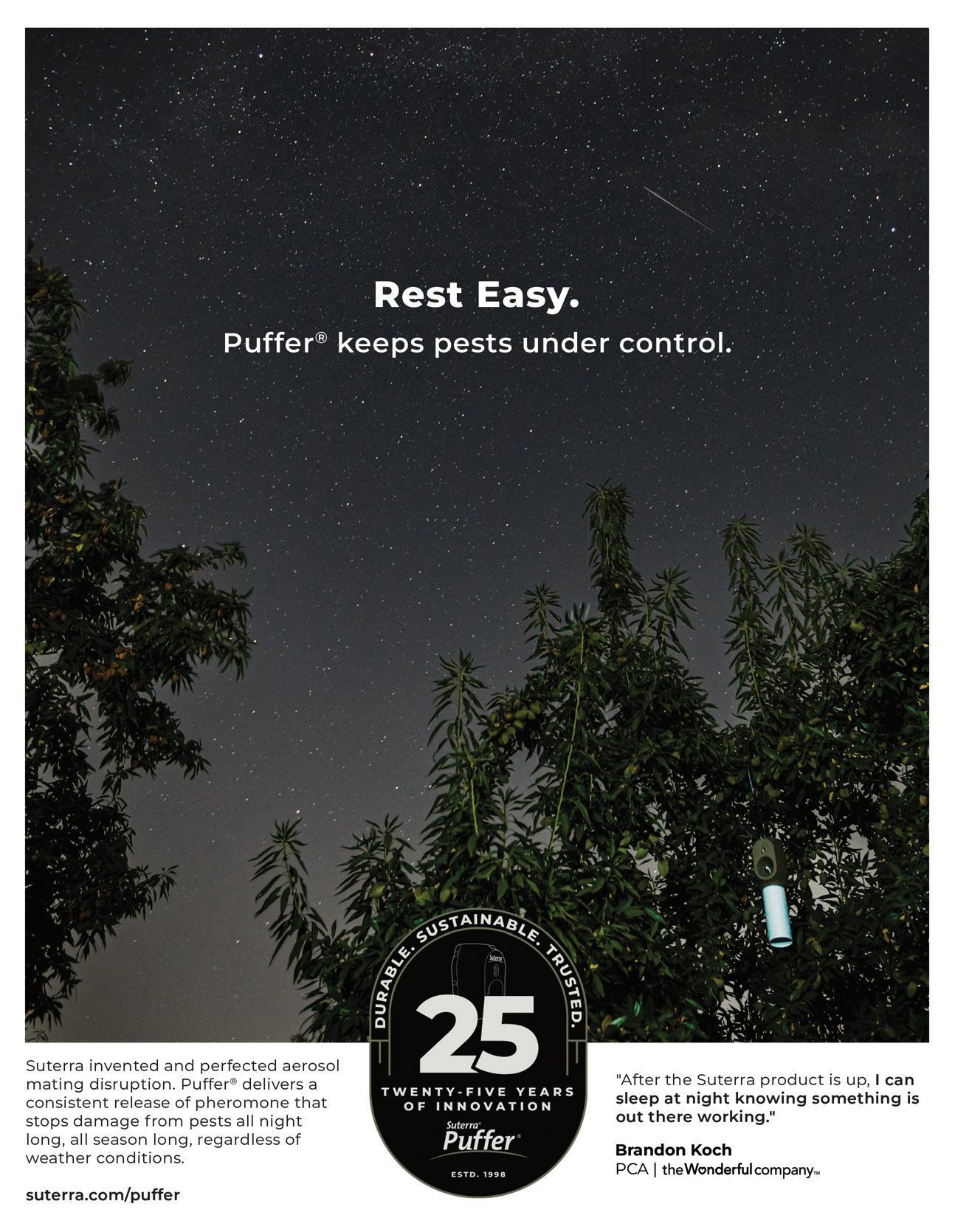
vember?), a high rate (20 lbs/acre) zinc sulfate spray delivers zinc into the trees and, as a bonus, drops rust- or shot hole-infested leaves.
Work out a gopher control plan for later this year when field work slows.
Possible wet winter? Time to think about root health and phytophthora prevention. Make sure there is a clear exit path for runoff water from the orchard and surrounding area with a potentially wet El Nino winter in the forecast. Talk with your PCA about phytophthora management options. Rotating fungicide chemistries is key to managing resistance. See link below for material choices and rankings. See UC IPM fungicide efficacy ratings and resistance management information in the link at the end of the column.
On the subject of winter water…The goal of water management in winter orchards is to maximize infiltration while making sure that the excess runs off completely. Cover crops and/or organic matter (compost, nut shell, etc.) helps soften the impact of rain on the orchard floor and help with infiltration. Better infiltration means improved salt leaching and groundwater recharge. Cover crop planting should be done by November 1. See link to Almond Board info on cover crops.
Nutrition
Where needed, a boron (B) foliar feed is the most important fall fertilizer practice in almond orchards. If hull boron
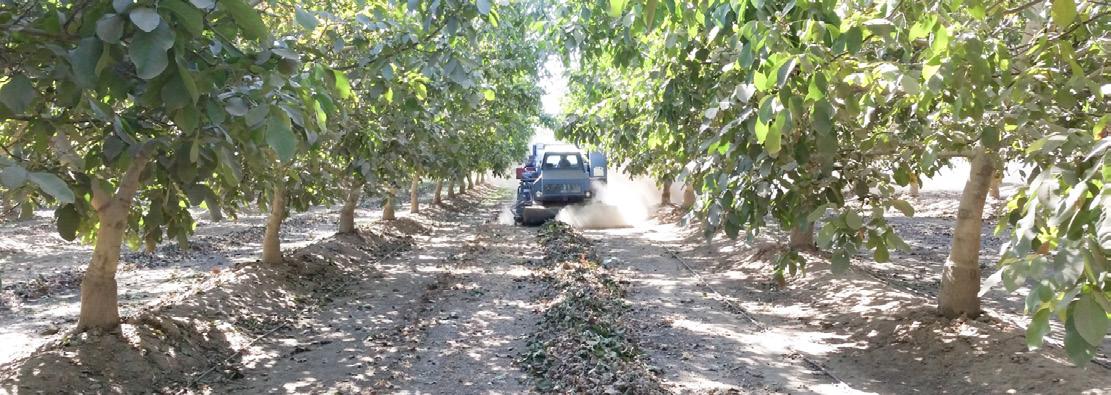
levels are low, applying 2 lbs Solubor/ acre (0.4 lbs B/acre) can increase yields by several hundred kernel pounds/ acre (this practice doesn’t reduce the need for bees, frost protection, etc. but it improves the results from those investments.) The added B helps with nut set at bloom, so the application must be ahead of bloom in the fall or at pink bud. October is a great time for this foliar treatment. Soil-applied B doesn’t reach spurs ahead of bloom and so doesn’t help with yield for the new crop. Check with your CCA regarding B rates and materials. If a spring/summer zinc foliar spray wasn’t done, consider adding 5 lbs zinc sulfate/acre to the B in early October to improve tree zinc levels. This “low” zinc rate in early October was as effective as 20 lbs zinc sulfate/acre in November in increasing zinc levels in peaches in UC research.
Talk with your CCA about potassium (K) rates and materials. Fall application of field-grade, less expensive SOP (sulfate of potash; potassium sulfate) fertilizer is an effective practice to load the soil w K ahead of the next crop. Almonds use 95 lbs K 2O per 1000 lb kernel crop, so use orchard crop history to set the annual rate of K 2O/ acre. Band or locally broadcast the dry fertilizer to make sure the fertilizer K is in the active root zone next year. In sandy soils where K leaching can remove some concentrated (banded) K, consider a light rate in the fall and fertigate the remaining annual budget K next season. In drip-irrigated blocks, put the fertilizer band near the drip lines where irrigation water reaches to ensure the roots will reach the K. Local
broadcasting underneath microsprinklers is becoming an accepted practice. A single band of K fertilizer per tree (only on one side, not both) works fine. Coordinate dry fertilizer application and sweeper work so the blower doesn’t scatter fertilizer.
Almond shell is 1.5% K 2O by weight (36 lbs K 2O/ton) and can contribute to an annual orchard K budget as well as help with rainwater infiltration and erosion control. See link, below, to info on applying shell.
Unless the summer leaf analysis results show low nitrogen (N) levels (less than 2.4% N), no fertilizer N need be applied before leafout next March. If leaf levels are less than 2.4% N, apply a low rate of soil or foliar applied N to “top up” woody tissue N storage going into the fall. Just 20 lbs N/or similar low rate will do the job as N use is very low this time of year. Once leaf drop has started later this fall, root uptake of soil N is very limited. Make any fall N application when the orchard has a full healthy leaf canopy.
Planning
Sometime this fall, take time to review the 2023 season (reject sheets, leaf analysis results, etc.) with your PCA and CCA. What worked and what didn’t for NOW management? How about nutrition? Where possible, make plans to adjust 2024 practices based on 2023 experience.
With light crops the last two years in the Sac Valley region and the state, the 2024 California almond crop could be in the 3-billion-pound range if bloom weather is good. This could mean no
ContinuedfromPage40
42 West Coast Nut October 2023
Whenever possible, shake, pickup and deliver walnuts on the same day for the best-quality product.
improvement in almond prices and a good-big crop set in many orchards. This will mean significant inputs of potassium and nitrogen to feed a big crop and pesticides to protect that crop. I think it’s better to budget for a big crop as much as possible in this market and go into next year aware of the possible situation.


Walnuts
A few points to remember during harvest and beyond. Fingers crossed for a better crop year than 2022.
Whenever possible, shake, pickup and deliver walnuts on the same day for the best-quality product.
Review summer leaf samples for possible nutrient deficiencies. For fall practices, especially consider K nutrition. Deficient orchards (0.9% leaf K or less) produce less crop than those with adequate (more than 1.2% leaf K) and should receive a banded application of up to 400 lbs potassium sulfate (200 lbs K 2O/acre). Walnuts remove 50 lbs K 2O per ton of nuts, assuming the whole nut (including hulls) are removed. If the hulls are left in the field, much less K is removed but left in the row middles in the hull tissue.
Postharvest, continue prepping your walnuts for the possibility of a hard freeze later this fall. Key points: Shoot growth should be stopped in September using water cut-off, then restart irrigation to reduce orchard stress. Keep orchard floor vegetation at 2 inches or less starting mid-October. If no/little rain through October, irrigate orchards to keep the soil moist ahead of forecast cold.
Finally, there is interesting information in recent UC walnut newsletters on practices/considerations for growing tomatoes after removing walnuts.
Best wishes to all for a safe and productive harvest.
Resources
Irrigation
UC ANR Pressure chamber use in almonds, walnuts, and prunes (27 pages) anrcatalog.ucanr.edu/Details.aspx?itemNo=8503
Advanced SWP (stem water potential) interpretation in almond.
sacvalleyorchards.com/manuals/stem-water-potential/advanced-swp-interpretation-in-almond/
Pests
UC IPM Navel orangeworm management ipm.ucanr.edu/agriculture/almond/navel-orangeworm/
UC IPM San Jose scale management ipm.ucanr.edu/agriculture/almond/san-jose-scale/
Growing the Valley Podcast (UCCE) on gopher management (with links to more information) growingthevalleypodcast.com/ipm-1/2022/2/24/pocket-gophers-with-roger-baldwin-7d54t
UC IPM Fungicide and Bactericide Efficacy and Timings Publication, 2022 ipm.ucanr.edu/agriculture/ scroll down to “More Informa-
tion” for the link. See pg 37 for phytophthora materials.



Nutrition
Almond hulls and/or shells are potassium source. sacvalleyorchards.com/blog/almonds-blog/applying-amendments/
Cover crops
Almond Board of CA Cover Crop Guide almonds.com/almond-industry/industry-news/questionsabout-cover-crops-new-bmps-can-help
Planning
NASS Almond Acreage Report for 2022 (April, 2023 release) nass.usda.gov/Statistics_by_State/California/Publications/ Specialty_and_Other_Releases/Almond/index.php
Walnuts
Protecting walnuts against winter freeze damage sacvalleyorchards.com/walnuts/horticulture-walnuts/prepare-for-next-sudden-autumn-freeze/
Tomatoes following walnuts: cesutter.ucanr.edu/news_204522/Sacramento_Valley_Walnut_News_135/
Comments about this article? We want to hear from you. Feel free to email us at article@jcsmarketinginc.com
Barrett30: The Ultimate Nematode Control Solution


Barrett30 targets and eliminates nematodes leaving plants and soil unharmed. Growers benefit from controlling pests with our soft chemistry that is nonsystemic, uses minimal active ingredients and leaves zero trace of Barrett30 in the final product.
Say goodbye to nematode worries and hello to a successful harvest with Barrett30!
(209)
Secure healthier crops with Barrett30
409-2558
barrett30.com chad@bpscience.com
October 2023 www.wcngg.com 43
Labor, Cost Savings Highlighted at Nut Growers Society Summer Tour in Oregon
By MITCH LIES | Contributing Writer
Labor and cost saving options were front and center at the 2023 Nut Growers Society (NGS) Summer Tour on August 2 in Albany, Ore., with demonstrations of an intelligent sprayer and a mechanized pruner among morning highlights.
In addition, growers were provided information on pest management strategies in an afternoon session that included three hours of presentations. And hazelnut industry suppliers and affiliated industries packed the Knife River Training Center with booths and equipment.
The day started with four breakout sessions, two of which were all about cost and labor savings.
Oregon State University Extension Plant Pathologist Jay Pscheidt said that in grapes and several other crops, growers were saving up to 70% on material costs when using the Intelligent Spray System, which sprays only when plant canopy is present.
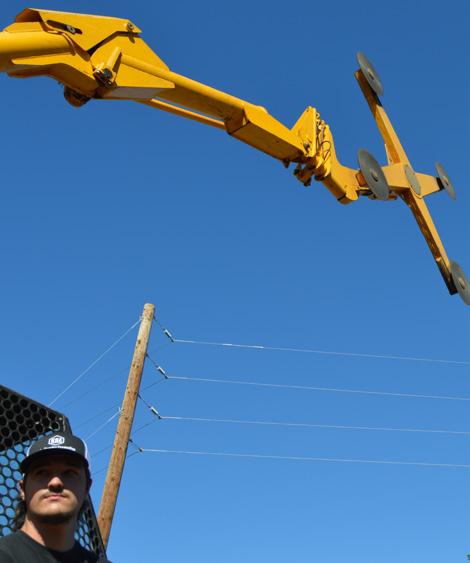
And, he said, a reduction in spray volume provides labor savings by minimizing the number of fill-ups during a spray operation. “You’re saving on labor because you aren’t going back to refill
constantly,” Pscheidt said. “And you’re saving on water.”
The Intelligent Spray System, which is being sold by Smart Guided Systems, was developed by USDA-ARS’s Application Technology Research Unit (ATRU) with competitive funds from the National Institute of Food and Agriculture.
The system has 10 years of research and field testing that shows it increases precision and accuracy while reducing pesticide use when chemicals are applied. Studies at USDA-ARS ATRU, The Ohio State University, Oregon State University and University of Tennessee show a reduction in pesticide use of 47% to 73% with comparable insect control efficiency and equal or better disease control, according to Pscheidt.
The system is expected to be particularly beneficial when treating young orchards, said Brent Warneke, faculty research assistant.
“It adjusts the amount of spray it applies in real time based on the canopy density that it sees with a laser sensor,” Warneke said. “In a young orchard, you could see 70% in savings on materials.”
The system, which can fit onto any
spray rig, includes a fan that blows air on the laser to keep off dust, and a GPS to track the speed of the tractor and synchronize spray output with what the laser is seeing. “And a very important component of the system is individual solenoid valves at each nozzle body that pulse 10 times per second and are able to adjust how much time they’re open in each one of those pulses,” Warneke said.
The system operator can set viewing angle, viewing distance and other parameters for each nozzle with a tablet computer, allowing an operator to change settings for different crops, Warneke added.
Mechanical Pruner
A second breakout session included a presentation on a mechanical pruner.
Matt Miller of Miller Hazelnut Farms in Hubbard, Ore., said mechanical pruners like his have been around for 40 or 50 years. When he purchased one five years ago, however, he said he was only the sixth person in Oregon to buy one. He connects the pruner, manufactured by TOL Inc., to a John Deere 6210 tractor.
44 West Coast Nut October 2023
Matt Miller of Miller Hazelnut Farms at the Nut Growers Society Summer Tour provides tour participants information on a mechanical pruner (all photos by M. Lies.)
“We prune anything from five-yearold trees to 80-year-old Barcelona and everything in between with this,” he said.
The pruner’s four saws cut multiple wood diameters, he said, with the smaller-diameter wood easier to cut and faster to get through.
“This will cut two- to four-inch diameter wood all day,” he said. “And on average, if you’re cutting two- to fourinch stuff, you can do 30 to 40 acres a day pretty easily.”
Miller noted he was cutting an orchard for a friend that had six-inch wood and he still got through six acres in 16 hours. “I was in creeper gear,” he said, “as slow as this thing would go.”
The most acres he has ever pruned in a day was “75 or 80 acres” of a prune orchard, he said. “But that was wood the size of your thumb,” he said, “pretty small diameter stuff.”
The pruner includes four circular saws attached to a long arm that can extend up to 30 feet. “I can top from 2 feet to about 20 feet,” Miller said. “And


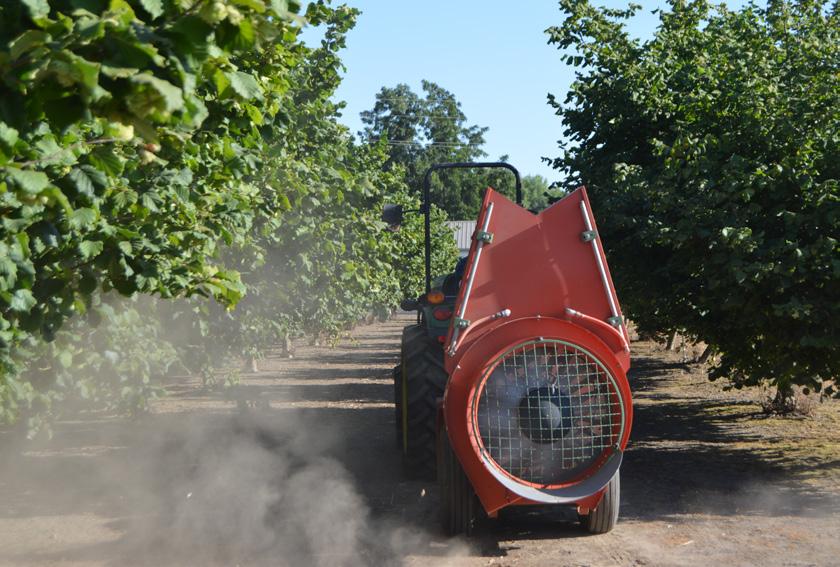
ContinuedonPage46
October 2023 www.wcngg.com 45
Researchers provide participants at the Nut Growers Society Summer Tour with a demonstration of the Intelligent Spray System attached to an air-blast sprayer. 10 years of research and field testing show the system can increase precision and accuracy while reducing pesticide use.
then I can flip it on its back to skirt the underneath of a young tree.”
Miller said he likes to keep aisles as clean as possible. “So, we do a vertical cut to make the aisle about 8 to 10 feet wide roughly as high up as we can go so there is a lot of light getting from the top to the bottom, and we get better spray coverage.”
Maintenance on the pruner is relatively simple, he said. “The main thing is there are just a lot of pivot points to grease,” he said. “And the four saw blades are powered by belts, so you have to keep the tension on those. If I’m cutting small, I’ll go a day or two without adjusting them. But if I’m cutting big wood, I make sure to check them in the morning and at lunch, because you can fry a set of belts on this pretty quick if you’re not careful.
“But other than that, everything is hydraulic,” he said. “The tractor PTO runs a hydraulic pump that runs the blades and the cross. And the up-and-down and the angle of the boom is run off the hydraulics remote on the tractor.”
Soil Health

A third breakout session was all about soil health.

Shannon Cappellazzi, director of research for the Salem-based GO Seed, said soil health is key to maximizing yield potential in hazelnuts. And, she said, the single biggest activity growers can do to improve soil health is to keep soil covered with living tissue.
“The No. 1 way that we feed organisms in the soil is by having living plants,” Cappellazzi said. “When we have living plants in a system, we are able to feed the microbial community.”
She added the more diverse and abundant a soil’s microbial community, the better soil functions.
To increase cover crop usage in hazelnuts, Cappellazzi said that she, OSU Extension Orchard Specialist Nik Wiman and OSU Statewide Soil Water Quality Extension Specialist Abigail Tomasek have a grant proposal titled “Overcoming Barriers to Cover Crop Use in Hazelnut Production” in which they plan to interview hazelnut growers who use cover crops.
“There are some really practical reasons why people manage a bare orchard floor,” she said, including that growers like to harvest from a bare floor and have harvest equipment designed for bare-floor harvest. Also, she said, growers are concerned that vegetation on orchard floors increases pest pressure.
But, Cappellazzi said, there are many hazelnut growers in the Willamette Valley who successfully utilize cover crops in their operations.
“So, what we are doing is we’re talking to them about what they’re seeing as far as the benefit,” she said. “Why do they think that it is useful to have those [cover crops]? And what are they doing to make that work? What do those pest pressures look like? What does the economic situation look like?”
The project also includes taking soil samples to gauge whether soil under cover crops is actually healthier in terms of its ability to function.
Overall, James McDonald, president of the Nut Growers Society, characterized the 2023 NGS aHSummer Tour as a huge success.
“It’s been a great day,” he said in late afternoon. “We had a lot of good participation and had great enthusiasm.
“There has been a lot of research disseminated today, which has been great to learn about,” McDonald said. “I’m looking forward to getting back to the orchard tomorrow with some new knowledge.”
Approximately 600 attended the event, according to the Hazelnut Industry Office.
ContinuedfromPage45 Comments about this article? We want to hear from you. Feel free to email us at article@jcsmarketinginc.com
46 West Coast Nut October 2023
Hazelnut industry suppliers and affiliated industries packed the Knife River Training Center with booths and equipment at the Nut Growers Society Summer Tour in Albany, Ore.

TIMING, PREPARATION ARE KEYS TO SUCCESS WITH PREEMERGENT HERBICIDE PROGRAMS
By CECILIA PARSONS | Associate Editor
There are several good reasons to consider implementing a preemergent herbicide program in your orchard: residual activity, resistance management and it takes place during a slower time of the year.
UCCE Weed Specialist Brad Hanson said for getting a jump on weeds, the longer duration of effectiveness and performance of preemergent herbicides should make them the foundation of a weed control program in orchards.
“Get preemergents in the soil before the major weed flush in late fall and early winter,” Hanson advises. “You can control 80% of the weeds and will have fewer weeds later in the season,”
It is the timing of preemergent applications that is critical. Hanson said there are two schools of thought about when to apply preemergent herbicides: Wait until January and risk missing in
the early germination of weeds or early application in early December to catch the first flushes. He advises the second approach as there is less risk of orchard inaccessibility due to rain. The early weed flushes targeted include winter annual grasses which emerge as soils cool in the Sacramento Valley as well as fleabane, malva and fillaree farther south.
The UC IPM weed management guidelines note that although preemergent herbicides have a greater initial cost than most contact herbicides, the residual weed control may provide sufficient control that a postemergent application could be eliminated.
Hanson said sequential treatments of preemergent herbicides involves an initial herbicide application in the November to January time frame depending on location and a second
application in March to target summer annual grasses.
“You have to look at this as using the right tool at the right time,” Hanson said. “Half the rate at the right time is better than twice the rate at the wrong time.”
Sequential Applications
Reliance on the residual effect of preemergent herbicides may lead growers or crop advisors to use high rates of the product or delay applications. UCCE Orchard Systems Advisor Phoebe Gordon said. Sequential applications use the same amount of herbicide only in two doses to better target problematic weeds.
Bayer Crop Science Customer Business Advisor Manuel Jimenez agreed, noting growers using dual applications timed in November to March implement this preemergent herbicide strategy in orchards.
“Materials are pricey, but a good investment,” Jimenez noted. This year’s higher weed pressure is adding to the seed bank in the soil and may mean an even weedier 2024.
He said the dual approach can be effective particularly if a broad-spectrum product is mixed with an herbicide that targets resistant weed species.
Applying preemergent herbicides includes paying attention to orchard floor conditions in addition to timing. The application will be more effective if the orchard floor is smooth with no ruts to channel away herbicide or leaf trash to prevent it from hitting the soil.

Cameron Zuber, UCCE orchard crops advisor in Merced County, said with preemergent herbicides, the aim is to inhibit the growth of seedling roots, shoots or both. The herbicides need to be in the top layer of the soil, not on top of the soil, to be effective. He said preemergents tend to bind to organic matter in the soil or the soil itself which helps limit leaching, but it doesn’t stop it from happening. Clearing orchard berms of leaf cover or debris allows the herbicide to hit the surface of the soil.
Zuber said most preemergents need between 0.25 to 0.75 inches of rain or irrigation within a few weeks of the application for best results. The UC publication Sac Valley Orchard Source noted that
48 West Coast Nut October 2023
Blowing leaves and debris off the tree row is necessary for preemergent herbicide efficiency. The product must be in the soil to work (photo by C. Parsons.)
even in 2013-14 drought conditions, many of the preemergent herbicides worked surprisingly well despite several weeks on the soil surface with minimal incorporation. To maximize the impact of preemergence herbicides in a weed management program, a short irrigation set is advised if rain is not forecast.
Tank mixes or sequential herbicide applications broaden the spectrum of weeds controlled and reduce selection for resistant populations. Tank mixes can take several forms: preemergent and postemergent herbicides to control emerged weeds and provide residual control; combining herbicides with activity on grasses with other materials with broadleaf activity; or combining material with different modes of action but overlapping activity on weed species.
Weed Survey
The UC Integrated Weed Management website advises growers or crop consultants to conduct a late fall weed survey in their orchards after the first rains of the fall when winter annuals have germinated and started to emerge. This helps by identifying remaining summer species and perennial weeds that escaped last year’s weed control program. Fall monitoring will also identify winter species.
Zuber said it really helps to understand what was missed from that year and have a sense of what could be problems going into the next year. By “miss” he means not identifying the weed in the first place to be targeted. Also, the weed may have been identified and targeted, but the product used and its effectiveness or lack of was not recorded. The UC Davis Weed Research Center website has weed ID tools.
Berm or Middles?
Many growers tend to focus on their berms/tree rows versus the middles/alleyways with any herbicide management, but especially with preemergents, Zuber said. While the needs for preemergent in the middles can be debated due to costs, it is still a part of the managements as noth-
ing lives in a bubble and seeds tend to move. The middle can be the source of those seeds you are trying to inhibit, so incorporating middles (either through identification or other means) is important.
Hanson said while most preemergent use is in the tree row, he is seeing more ‘trunk to trunk’ weed control in orchards. This approach can cut down on mowing and spraying in the middles and the resulting soil compaction.
Newly Planted Orchards
Weed control is especially important during the first few years of orchard establishment. Competition from weeds during this period can result in reduced tree vigor and productivity. Weedy orchards may require several more years to become economically productive than orchards with effective weed management. Regardless of the method to control weeds, care must be taken not to injure the young trees with herbicides or to mechanically damage the trunk or roots. As the orchard
becomes established, competition from weeds is lessened as shade from the tree canopy, especially in densely planted orchards or in orchards with large-stature trees, reduces weed growth.
Preemergent herbicides should only be applied in newly planted orchards after the soil has completely settled around the tree to reduce the chance of tree damage. The risk of damage is greater if the trees settle after treatment because the herbicide has a greater chance of coming into direct contact with tree roots.
Regardless of the postemergence herbicide used, protect the foliage and bark of young trees from direct spray or spray drift to avoid tree injury. Young trees are very susceptible to damage from herbicides. Placing plastic or cardboard wraps, cartons, or sleeves around the tree trunks is helpful in preventing herbicide contact with young trees.
Comments about this article? We want to hear from you. Feel free to email us at article@jcsmarketinginc.com

Contact us for complete details. GET EVERY NUT 1-800-288-8128 • www.tgschmeiser.com October 2023 www.wcngg.com 49
The New Schmeiser V-Blade Roller combines all the advantages of a durable V-Blade with a Rear Roller to provide groove-free smoothing and reduced loose dirt at the row ends.
WEED CONTROL SOLUTIONS FOR ESTABLISHED ORCHARDS AND NEW PLANTINGS

Pre- and early post-emergence control of important weeds like fleabane, marestail, filaree, malva, willowweed, annual bluegrass and Italian ryegrass on all key permanent crops. No soil type or organic matter restrictions. No dormant or nondormant cut-off dates. Can be applied to young trees and grapevines that have been established for at least one full growing season. Fit: Excellent tank mix with Pindar® GT herbicide, oxyfluorfen and Alion in “residual” programs.
Long-lasting pre-emergence control – up to six months – of the toughest broadleaves, including fleabane, marestail, filaree and malva. Plus, post-emergence activity on many winter and summer annual broadleaves, including fleabane and marestail.
Fit: Excellent for “residual” programs that minimize the number of contact herbicide applications needed for clean-up sprays. Often tank mixed with Matrix® SG or Alion.
50 West Coast Nut October 2023
Fit: Ideal for new plantings. A pre-emergence herbicide providing four+ months of weed control. 92 broadleaf weeds on the label, including marestail, fleabane, malva, clover, morningglory and willowherb. Non-volatile and will not lift off the soil (i.e. volatilize) to injure plants. As a non-systemic herbicide, it will not translocate into plant roots. It can be applied as soon as the crop has been planted and the soil has “settled” around the base of the plants.

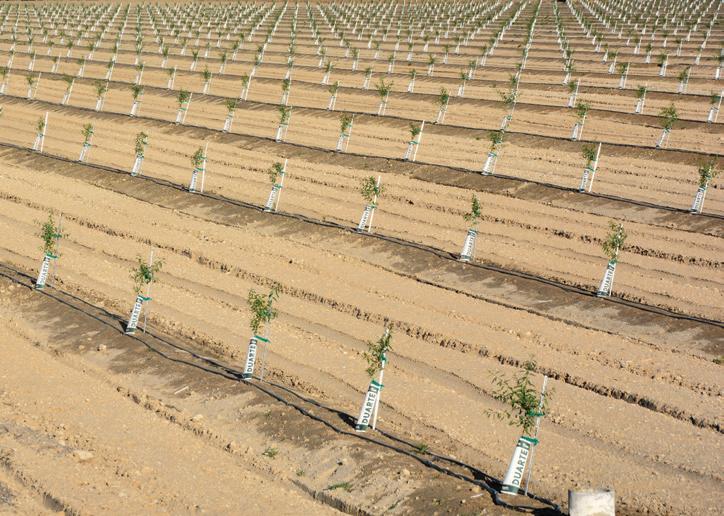
Post-emergence herbicide containing an innovative choline formulation of 2,4-D with near-zero volatility. It can be used in most tree nut crops, stone fruit, apples and pears, and controls numerous broadleaf annual, biennial and perennial weeds. Systemic action helps provide a thorough kill of weeds. Fit: In tree nuts, excellent in dormant, “in-season” and “post-harvest” clean-up sprays and as a tank mix in “residual” programs in late fall and early winter.

October 2023 www.wcngg.com 51
Visit us at corteva.us ®™Trademarks of Corteva Agriscience and its affiliated companies. Embed® Extra, Matrix® and Pindar® GT are not registered for sale or use in all states. Contact your state regulatory agency to determine if a product is registered for sale or use in your state. In Florida, Embed Extra is labeled under FIFRA 24© for Selective Control or Suppression of Emerged Broadleaf Weeds in Citrus Grove Floors. Consult the Supplemental Labeling for the specific restrictions in your area or call 800-258-3033 for more information. Always read and follow label directions. ©2021 Corteva
Researchers Present Data on Preplant Alternatives for Nematodes in Walnuts at Field Day
 By KRISTIN PLATTS | Digital Content Editor
By KRISTIN PLATTS | Digital Content Editor
The results of a UC study focusing on nematodes in walnuts were presented recently to the public. UC Riverside Nematologist Dr. Andreas Westphal delivered the findings from the trial to a group of growers, PCAs and other members of the industry at the Escalon, Calif. trial site during an open UC ANR-sponsored meeting on August 17. Research on the orchard trial, which began in summer 2020, has focused on alternatives to current nematode management treatments to prevent nematodes in new orchards following walnuts or other nut crops.
Most currently used rootstocks in walnut production are susceptible to plant-parasitic nematodes, especially to the root lesion nematode (RLN), Pratylenchus vulnus, according to Westphal, who said that as few as one nematode per 250 cc of soil at planting can be damaging to walnuts.

Because of this susceptibility, Westphal says soil sampling when planning and preparing for a new orchard planting is crucial. In recent years, preplant treatments have heavily relied on the use of 1,3-dichloropropene often formulated as Telone. In replant situations, Telone is often co-applied with chloropicrin which has higher activity against other soilborne microbes.
At this walnut replant RLN-infested site, different preplant treatments were applied in August 2020. The whole trial was then planted to ‘Livermore’ on
‘Paradox Hybrid’ seedling rootstock in winter 2021.
The field day allowed attendees to see the treatment scenarios that were tested at the trial site and the various ways they have been applied.
In total, nine different treatment regiments, preplant treatment plus at-plant and post-plant application patterns were illustrated at the research plots. These included: (a) non-treated, (b) Dominus, (c)Velum One, (d) ASD
Brassica cover crop, (e) ASD Sudangrass ‘Piper,’ (f) Telone-chloropicrin co-applied, (g) Salibro, (h) ASD Rice bran and (i) ASD Sunnhemp Crotalaria.
In the study, several treatments showed improved growth over the non-treated control, Westphal said. Trees following Telone application presented the strongest vigor, but regulatory changes may limit the feasibility of its use in the future.
“Yes, Telone is still a very good
UC Riverside Nematologist Dr. Andreas Westphal shares results of a UC ANR-sponsored field day in Escalon, Calif. on August 17 that focused on alternatives to current nematode management treatments to prevent nematodes in new orchards following walnuts or other nut crops (all photos by K. Platts.)
52 West Coast Nut October 2023
Signage at the field day identifies a plot of walnuts pre-treated with Salibro nematicide.
material. The regulatory changes will modify its use pattern creating possibly higher expenses and less efficacy,” he said.
Currently, Telone applications are not without difficulties in fine-textured soils and if soil conditions are too wet. Telone is injected into the soil as a liquid. There, it becomes a gas that then redistributes in the soil matrix. If many of the soil pores are filled with water, movement can be encumbered, and fumigation is liable to have less than optimal efficacy. Regulations scheduled to be in effect on Jan. 1, 2024 call for higher moisture in the soil, deeper injections or covering with totally impermeable film (TIF) tarp.
Westphal cautions to keep in mind that most nematodes are fairly deep in the soil, and when soil was sampled from zero to five feet depths in the study, large populations were often found at great depth.
WalnutTek Advantages
• Walnut sorting at the huller, and in-shell
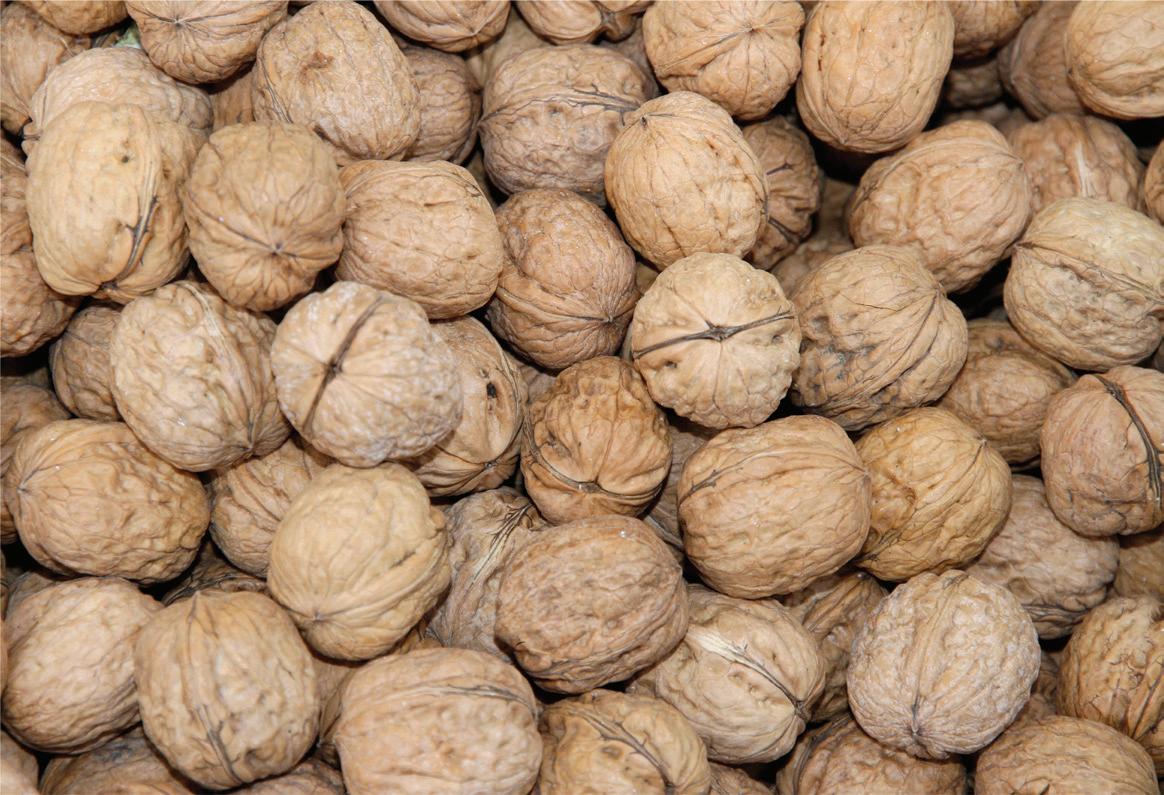
• Green and black re-sorting at the huller
• Several width options — 32, 48, 64 or 80in
• Capacity from 5-30 tons/hour
Automated Moisture Monitoring at the Dryer
All moisture meters are available for use individually or in conjunction with the WalnutTek sorter.
• Hand-held moisture meter
• Automated moisture meter
• Automated moisture meter with door control
• Automated moisture meter with door control
• and bin fill
AgTrack
• Traceability from the farm-to-processor
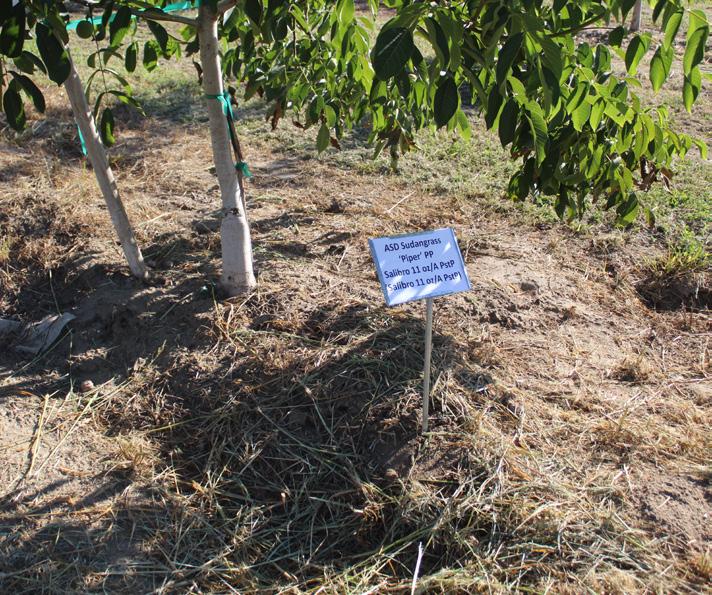
Woodside Electronics Corp.
1311 Bluegrass Place, Woodland, CA 95776
Phone: 1-530-666-9190
• Fax: 530-666-9428
Website: www.wecotek.com
Chris Sinclair 530-979-7633

16 Years in Walnuts | 30 Years of Sorting in the Field LOCAL FULL SERVICE! TECHNICIANS AVAILABLE 24/7
ContinuedonPage54
October 2023 www.wcngg.com 53
This walnut test plot at the UC trial was pre-treated with Sudangrass ‘Piper’ PP.
“Frequently, there are these populations at great soil depths, and we need to be concerned about them when we want to do preplant treatment,” he said.
He also noted it’s extremely important the active ingredients are delivered at the right depths.
“The chemicals tested in this trial, Dominus, Salibro and Velum One, are all poor or non-fumigants, so they need to be administered to the site where the nematodes are in the soil profile,” he said. “That’s why we delivered them by soil drenching.”
Westphal said anaerobic soil disinfestation (ASD) has also shown promise in collaborative work with Dr. Greg Browne and Dr. Dan Kluepfel in other settings. In this process, easily decomposable substrate is incorporated into the soil, which is kept at high soil moisture conditions under tarp for about one month. The developing anaerobic conditions then kill microbes and nematodes in the soil.
Frequently, rice bran is used as substrate for this process. When talking about ASD further, Westphal said the treatment is expensive and might not be applicable in all situations. Logistics may also be challenging when coordi nating the different processes necessary for the method.
In the Escalon trial, Westphal’s team grew Sudangrass ‘Piper’, radish, and Sunnhemp cover crops from May 2020 to August 2020.
“The idea was that we produce the biomass for ASD in the field where this


is going to be administered,” he said. Sunnhemp and Sudangrass used for ASD were followed by improved plant growth but surprisingly radish, a popular biofumigant in annual crop production, didn’t work as well as they had expected, tending to incumber tree growth rather than helping it.
“It seemed to be rather damaging to trees when we used the radish material plus some mustard seed meal as substrate for ASD,” Westphal said. “And that seemed to mirror what we saw in almond trials where we use radish as a companion crop being planted very close to the trees.”
The Long Game
The damage caused to walnut trees by nematodes can be fairly nondescriptive. Oftentimes trees seem to not grow quite right, lagging behind others in the same orchard, Westphal explained.
“Many times in an orchard there is quite a lot of variability from tree to tree that shouldn’t be there if the trees are on the same rootstock” he said. “The damage is caused to the plant by the nematode-consuming nutrients that it uses for its own use.”
A not-so-surprising finding from the trial was that walnuts are very sensitive to nematodes, but their sensitivity
how the treatments fare between the poorest and the most vigorous treatments will be critical to assess their utility.”
As with other UC studies, the research conducted on the nematode trial
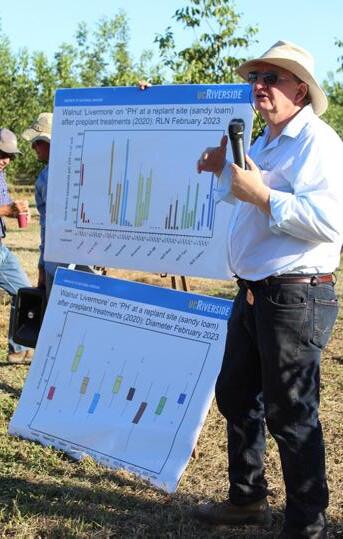
STEEL BUILDINGS
Whether it’s a design-build project, renovating and/or expanding an existing building, Hilbers Inc. and Butler have the expertise to see you through to the completion of your pre-engineered metal building project!
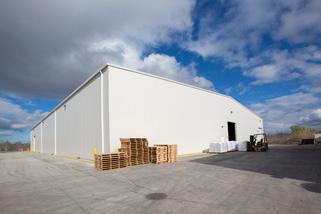
Proudly operating as 100% employee-owned. We build structures and Relationships to last.



HILBERSINC.COM 530.673.2947 770 N. WALTON AVE SUITE 100 YUBA CITY, CA 95993 Hilbers Inc.
with
is the team you can trust.
partnering
Butler
ContinuedfromPage53
54 West Coast Nut October 2023
Dr. Andreas Westphal presents field day attendees with a graph showing the results of walnut pre-plant treatments.
full productive capacity,” he said.
Westphal works on topics like the nematode issue not only in walnuts but in almonds and grapes as well. He hopes to be able to conduct a similar trial to this one on almonds and is looking for growers who might be willing to collaborate.
“We are looking for a site where we can do some preplant treatments for almond, which have a slightly different nematode problem than walnuts but, overall, have a very similar challenge,” he said.
The five-acre orchard where the walnut nematode trial is taking place was donated by Robert Longstreth. The site allowed for a larger expanse of their research than the research team has traditionally been afforded at the Kearney Agricultural Research and Extension Center in Parlier, Calif., according to Westphal.
“We are glad that Robert Longstreth is willing to help us so much and allowing us to use this site so that we could use treatments on a little bit larger of
a scale than we can do at our research center, where we test more, different treatments, but not at a larger scale like we can do here.”
Looking at New Solutions
Rachelle Antineti, who offers strategic business planning for agribusiness professionals and also works with local community colleges to build internship and apprenticeship programs, said she attended the field day for a number of reasons.
A significant portion of Antineti’s consulting clients include farm management companies and independent consultants, and she said several new companies have recently solicited her assistance in launching biological-based products.

“My primary objective was to gain insights into the current research outcomes and to familiarize myself with the strategic directions the University of California is pursuing in the domain of alternative fumigation methodologies,” she said.
Antineti said her key takeaway from the field day was about the persistent prominence of Telone as the industry benchmark for effective control measures.
“Conversations I engaged in with PCAs during the event indicated a unanimous agreement that, given its continued availability, investment in preplant fumigation remains advisable,” she said.
She added there was also a considerable amount of dialogue at the field day regarding ongoing research initiatives and their integration of biological products as potential alternatives to the prevailing industry standard.
“These preplant and post-plant solutions have exhibited some degree of success in the market, prompting my eagerness to deepen my understanding of their attributes,” Antineti said. “
Comments about this article? We want to hear from you. Feel free to email us at article@jcsmarketinginc.com
October 2023 www.wcngg.com 55
PUSHING THE LIMITS OF IRRIGATION EFFICIENCY: WHAT IS POSSIBLE?

 By TOBIAS OKER | UCCE Soils and Irrigation Advisor, Kern County
By TOBIAS OKER | UCCE Soils and Irrigation Advisor, Kern County
Water is a precious and sometimes scarce resource. In California, a state which comprises large arid and semi-arid regions, the role of water as a key cog in the wheel of economic development is an ever-present topic to various stakeholders. Although 2023 has been an unusually wet year to the extent that most of the state has been declared “drought free,” memories of recent drought periods are still fresh in the minds of many Californians, especially growers. Despite the aridity, California’s Mediterranean-type climate makes it suitable for year-round production of certain crops, especially vegetables, in addition to summer crops such as nuts and fruits for which it is well known.
The main limiting factor to crop production in a semi or arid environment, is water for irrigation, and in California, this is addressed through surface and groundwater resources. In the Central Valley, the surface water needed to sustain irrigation is transported from the Sacramento-San Joaquin Delta through a system of aqueducts, such as the Statewide Project which supplies about 34% of water for agriculture, and Friant Canal which provides water to irrigate about a million acres of cropland. However, being a drought-prone region, sometimes surface water resources become very limited or even unavailable due to little precipitation. Over the years, growers have had to heavily rely on groundwater during drought periods, and the cumulative effect of such withdrawals is manifested in markedly reduced aquifer water levels in some areas. In response, there are efforts to conserve and restore some of these severely stressed aquifers, and a major endeavor to this regard is the landmark Sustainable Groundwater Management Act (SGMA) passed
56 West Coast Nut October 2023
In a gravity flow system, the highest points in the orchard tend to get the most water. Newer systems are evening the distribution uniformity, improving crop health and reducing water use.
by the California legislature in 2014. SGMA’s goal is to guide the process of restoring the Central Valley aquifers by the early 2040s. One of the major impli cations of this is potentially significant reductions in amount of water available for irrigation. Faced with this pros pect, it is important to further explore opportunities that exist in technolo gies and management approaches that can help improve irrigation efficiency. Efficient irrigation systems are basically technologies coupled with management approaches that primarily ensure the least water loss, possibly savings in en ergy and other operation and manage ment costs.
Practices Advance Over Time

Irrigation in the western U.S. has undergone monumental changes from the earliest beginnings where gravi ty flow systems, or surface irrigation, based on water diversions from region al rivers and streams, or land reclama tion through drainage, facilitated the establishment of irrigated farms. This

approach to crop watering remained the most common method of irrigation until about the 1970s. In the peak era of

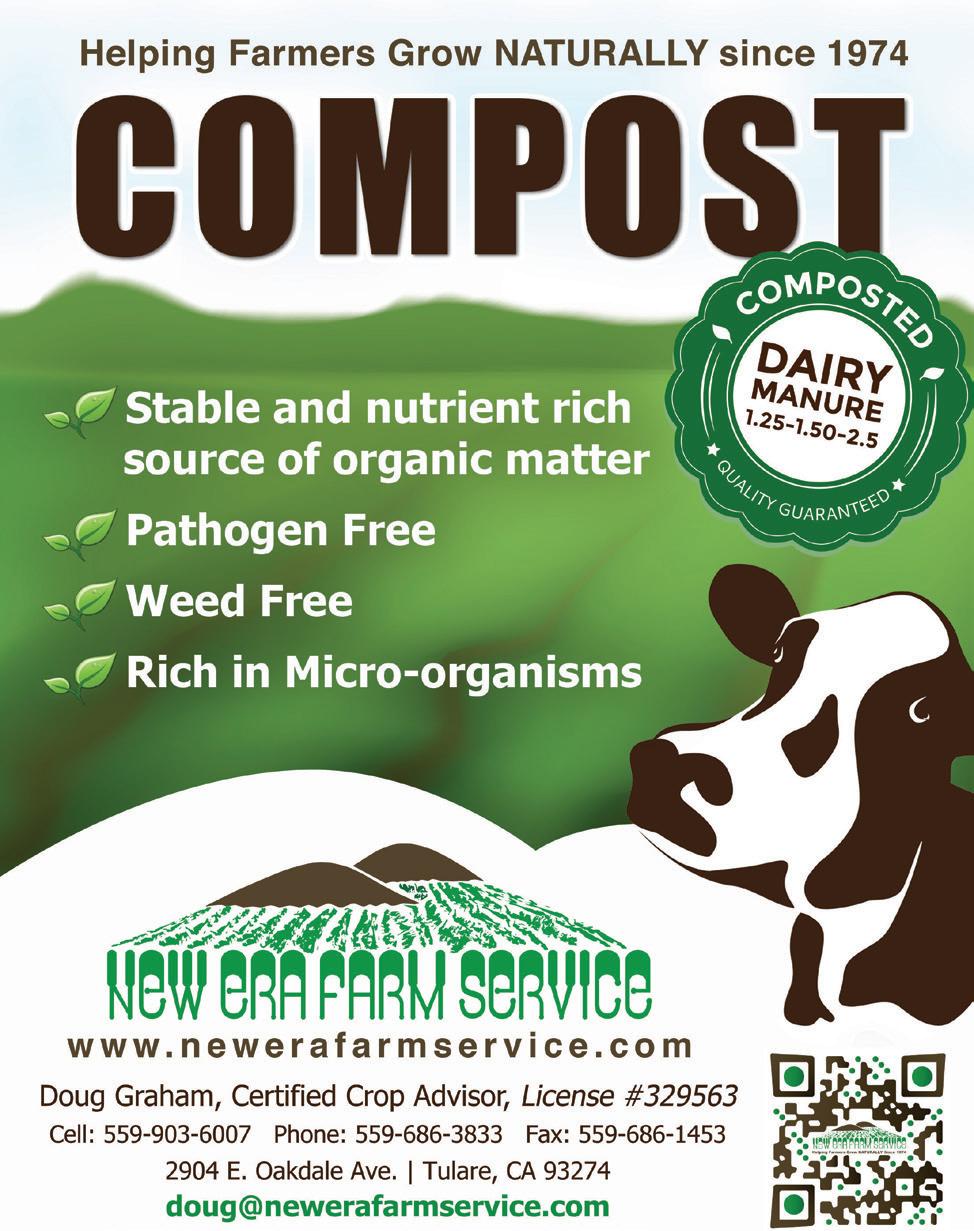
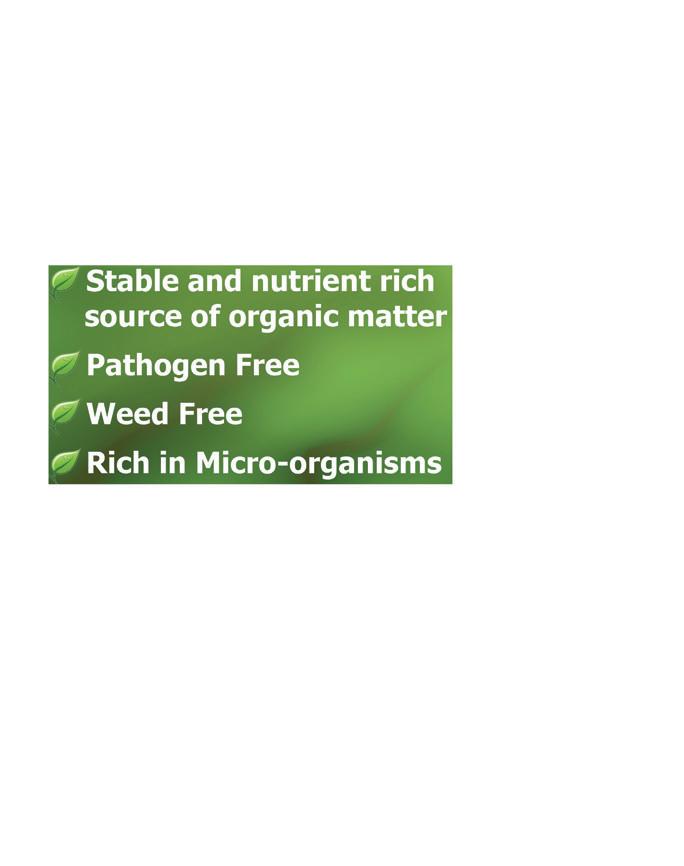
it relatively easier to apply water more uniformly across fields in comparison to gravity flow systems. To this end, modern center-pivot by Frank Zybach between 1948 and 1952 was a watershed
irrigation efficiency, it also addressed challenges of operating fixed-set and hand-move sprinklers. The first-generation center-pivots used high-pressure impact sprinklers operated at 70 to 100 PSI and high flow rates. The definingtion system is its ability to propel itself across a circular path in the field while fields to be irrigated using a few sprinklers. In traditional fixed-set sprinkler irrigation, usually a dense network of sprinklers has to be installed in order of self-propelling irrigation systems is
O ce: 559-686-3833 Fax: 5 59-686-1453 2904 E. Oakdale Ave. | Tulare, CA 93274 newerafarmservice .com
NATURALLY Since
October 2023 www.wcngg.com 57
Helping Farmers Grow
1974 ContinuedonPage58
ContinuedfromPage57

the linear-move sprinkler set, which in operation advances from one end of a field to the other in a straight line; after which it reverses direction to return to its start point. When well designed and managed, sprinkler irrigation systems can attain irrigation efficiencies as high as 70% to 85%. Today, center-pivot and linear move irrigation is popular in the U.S. and is picking up in some regions of the world. Modern units are fitted with low-pressure nozzles and can attain irrigation efficiencies as high as 90% when operated effectively.
A further improvement on pressurized irrigation is a class of devices collectively known as microirrigation systems. These typically include drip irrigation (surface, subsurface and button) and microsprinklers (or sprays). The higher irrigation efficiency of microirrigation systems is attributed to the fact that they are designed to apply water to only a fraction (33% to 60%) of the field. Usually, this is the immediate area near the base of the plant where there is likely to be the highest root density. They are particularly well suited to situations where crops are largely space, such as in orchards, and therefore irrigation should be limited to the root zone. When properly designed and managed, microirrigation systems can attain irrigation efficiencies above 90%. Of these, drip systems are known to be the most efficient. The most water-efficient form of drip is subsurface drip (SDI) which can attain irrigation efficiencies higher than 95%. In SDI the driplines are buried at depths usually ranging from 1 to 24 inches which significantly reduces evaporative water losses. In California, as much as 60% of processing tomatoes are grown using SDI.


58 West Coast Nut October 2023
The cost for modern microirrigation systems has become competitive given improvements in yield and high prices for water (photo by Taylor Chalstrom.)
Management in the Current Year
For a grower, many considerations go into the choice of an irrigation method in order to optimize profitability. Today, faced with competing water demands from other sectors coupled with supply uncertainty in some years, the question of irrigation efficiency is arguably one of the major issues that growers have to think about in their operations. A basic question to this end relates to how additional water savings can be attained through improved irrigation efficiency, and what it would take to make the transition for individual growers? A further question would be how sustainable crop production would be, even when using the most efficient irrigation methods under very stringent water availability conditions?
The most efficient irrigation methods usually have the highest capital costs, and this is usually the main constraint to adoption for some growers. This particularly used to be the case in the early years of microirrigation, but today, costs are relatively competitive when compared to other methods.
It is important to stress the point that even the most efficient irrigation methods are only as efficient as the overall management approach. Therefore, addressing any water loss pathways in an irrigation system is usually among the first things an irrigation manager should do. The integration of traditional irrigation management with modern tools such as electronic soil and plant sensors and information technology platforms is currently undergoing rapid growth in the U.S. and some areas of the world. Technologies such as variable rate irrigation (VRI) for center-pivots and linear-move systems, or remote zone control in largescale fixed set irrigation systems have advanced the feasibility of precision irrigation and with-it higher irrigation efficiencies.
In the last 40 years across the U.S., the amount of water used for irrigation has dropped from about 1.8 to 1.5 acre-feet per irrigated acre; roughly 17%. In the same period, the irrigated acreage increased from about 50 to 60
million acres. This could be attributed to a combination of factors such as the increased adoption of more efficient irrigation methods and the expansion of supplemental irrigation to the more humid eastern regions of the country. In a nutshell, more cropland is being irrigated with less water, which in the grand scheme of things is a step in
the right direction. A growing world population means more food has to be produced under more constraining conditions, and irrigation efficiency is one of the tools to realizing this.
Comments about this article? We want to hear from you. Feel free to email us at article@jcsmarketinginc.com
Prepare Your Nut Trees for Next Season
The SAN Agrow Post-Harvest Program is designed to increase root growth and improve nutrient uptake of fall fertilizers, preparing trees for next year’s growing season.

Apply a soil or foliar application within 30 days after harvest to:
■ Improve winter hardiness
■ Increase root growth and perennial wood

■ Improve fruit bud vigor, which can lead to reduced alternate bearing
Nut Tree Program Includes:



■ Organic TRIGGRR®
■ Organic BioLink® Cal-N
■ Organic BioLink® 3-3-4 Fertilizer
■ Organic BioLink® Micronutrients
Contact you local sales representative to learn more.
(760) 599-8855 or visit www.san-agrow.com

October 2023 www.wcngg.com 59
From the Orchard Stephani Graham and Rebecca Kaser Sisters Set Example for
Women in Tree Nut Industry
By LORI FAIRCHILD | Contributing Writer
For generations, farms have been passed down from fathers to sons, but sisters Stephani Graham, owner of Sol Aureus Farms, and Rebecca Kaser, owner of Avellar-Moore Farm, reflect a trend of daughters taking over the family farming operation in the tree nut industry.

Graham and Kaser didn’t expect to become tree nut growers. Despite their dad planting his first pistachio trees in 1982, neither sister had farming at the top of their list of future careers. Avellar grew up on the farm, but Graham lived in Southern California with her mother and only spent time on the farm during visits with her dad.
Including the acreage from their dad’s company, Steve Moore Farms, the three farm 1,100 acres in central California with Graham growing pistachios and grapes and Kaser overseeing almond and pistachio orchards.
Graham and Kaser shared their unique experiences as sisters in the tree nut industry with West Coast Nut.
Q. Give us a little background on your decision to join the tree nut industry.

Rebecca: I’m a fourth-generation farmer. My grandfather grew wheat,
and my uncle was in the cattle industry. Then our father invited us to join in the nut industry. Orchards were a whole new crop for us, and it was an opportunity to see where this would take us. I think it’s been fun, brought us all together.
Stephani: Rebecca’s family had a lot of ag background. I just had my dad’s half. My mom came from Chicago, so I didn’t have nearly the experience and exposure that Rebecca did.
Our father, Steve Moore, had cherries and almonds then planted pistachios in 1982. He planted his second block in 1995 and his last block in 2008. In 2012, our father offered up the opportunity to work in agriculture as a family group. We were both offered 160 acres to work with.
I didn’t have any experience with it. So, for me getting into it, I was thinking, ‘You know, this is generational information he doesn’t want to just disappear when he’s ready to retire.’ He wanted to pass it forward. So, for me, I was thinking, ‘This is a good opportunity to carry that forward.’
Q. What was the biggest challenge getting into the business without much in the
way of an ag background?
Stephani: I think for me, it was just soaking up the information, getting the information, learning how it was applicable. There’s so much to it. You’ve got the different trimming of the trees, why you do it, what the biggest pests are that you want to avoid, how much water you need, how does the processing work. It took a while, at least for me, to get my head fully wrapped around what was involved in it, how those systems worked.
Rebecca: It was a lot for me even coming from an ag background. I kind of had the idea of what it was like to go through the phases and the seasons and how the industry, no matter how much effort you put into it, you could be affected by the weather. When I did come on board in 2012 with my degree in psychology, I ended up going back to school to learn accounting and business so that I could have a better grasp on how to manage the farm.
Q. Tell us a little bit about how your businesses work together.
Rebecca: When we first came on board, my dad delegated parcels out to both Stephani and I to operate and manage and from there we grew to add
60 West Coast Nut October 2023
Sisters Rebecca Kaser (left), owner of Avellar-Moore Farms, and Stephani Graham (right), owner of Sol Aureus Farms, joined the tree nut industry in 2012 after originally pursuing education and jobs in other fields (all photos by Gina Taro Photography.)
on additional acreage and additional crops to farm and manage as well. We started out under our father’s company, and then from there, we split off into our own individual entities for which we are the sole owners and operators, but we still operate under the family farm. We kind of have the best of both worlds.
Stephani: It was something that was done over time, which was good because as we learned what we were doing, more and more was turned over until now we have all established these separate entities but still operate together as a group.
Q. What challenges do you think the nut industry faces?
Stephani: Water is at the top of the list. Overhead costs and budgeting are next, and last but not least is how to continue growing in a state that has a lot of challenges and climate-based changes.
Rebecca: Managing water is a challenge. With SGMA, the whole state was divided into groundwater sustainability agencies (GSAs) which would manage the underground aquifers. Minimum thresholds were established by the GSAs and are implemented on us through a groundwater sustainability plan. From there, we’ve had to reduce our planted acreage in order to move water around to keep our existing plantings irrigated. It has made for a reduction in total crop size for the state of California.
Q. How have your growing practices evolved?
Rebecca: We’re utilizing newer technologies. We’ve outfitted a lot of our tractors with GPS to assist with driving them. We also use orchard mapping where they fly over, and they can look at the different zones of the trees where they’re being stressed from lack of irrigation. We also use individualized plant stress monitors and dendrometers to measure at the plant level what nutrient deficiencies or irrigation deficiencies are there. It all coalesces into this digitized map that you can pull up on your phone and make these real-time decisions based upon real-time data.
Q. What makes you hopeful about the future of the tree nut industry?

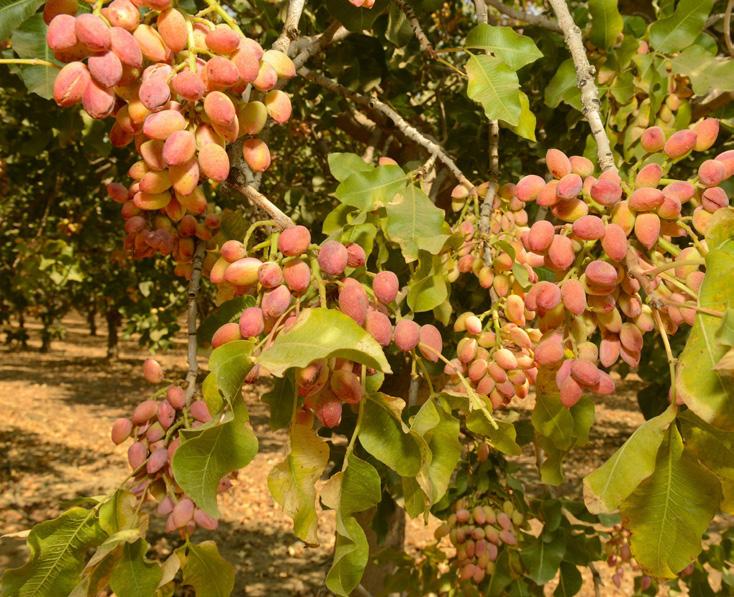
Rebecca: This is a great industry to be in. I’m excited because we’re producing a healthy product that’s natural, and we can provide it to others to maintain a healthy lifestyle. I’m excited to be able to participate in a voluntary commodity organization like American Pistachio Growers that helps support our efforts in nutrition research and marketing so that it can increase public awareness of this heart-healthy, plant-based protein.
Stephani: I agree 100%. It feels good to be a part of the solution nutritionally. My hope is that we can continue doing that, which is a big challenge with what
we’ve got going on with our legislation with the water situation that has put a lot of demand on growers and is really stressing farmers’ ability to continue. A lot of multi-generational farms have had to stop farming because of that. So, I’m really hopeful that we can come to some solution on all of these different areas so that we can all continue growing and providing that healthy food.
Q. What do you think needs to happen to keep multigenerational farms in business?
Stephani: Well, we need to get water. We need to come to some sort of ar-
ContinuedonPage62
Both sisters grow pistachios on their farms with Graham branching out into grapes while Kaser’s operation includes almond orchards.
Ongoing water management challenges mean
October 2023 www.wcngg.com 61
fewer acres of nuts harvested.
rangement, whether it’s water storage or recharging the aquifers. We need to get that into a structured set where farmers can continue. That’s a big problem, and we need our legislators and lobbyists up at the Capitol and in the country aware of what’s going on and what the need is.
Q. What would you say are the biggest assets of the tree nut industry in California?

Rebecca: I think it’s the community of growers. We’re able to come together and produce great products up and down the state. It’s the community of growers that come together for our commodity boards, the Almond Board, the American Pistachio Growers. We get together, and we all network and share ideas and use our resources to find research to really extol the benefits of the products that we’re growing and to really show the value of our product.
Stephani: Another strength is our resources. We’ve got programs out there that help existing and new growers to learn. There’s the Lead On program through American Pistachio Growers. They have all these different avenues to come together to help educate and inform and keep everybody on the same level of understanding of what’s going on and what needs to happen to keep it all going.
Q. What advice would you give to other women looking to get
into the tree nut industry?
Rebecca: Network with others. Don’t let anybody stop you. Make friends.
Stephani: Develop a thick skin and don’t be afraid to speak up. As with any industry for women, you’ve got your people that are going to be a little more antiquated, but honestly, it hasn’t been too much of that. We have had a pretty good response, especially out of the younger growers. I mean, there are more women in agriculture now. I think a lot of people aren’t aware of it, but it’s becoming more of a thing now, which is really great. Over the past 12 years, I have witnessed a vast improvement in acceptance and attitude toward women. Press forward and don’t look back.
Q. What is your proudest achievement as it relates to your professional development?
Rebecca: We’ve come together with other groups of growers to build groundwater recharge projects on our farm sites. It has helped us to be more sustainable in our practices, and what’s good for the crop is good for the soil. These groundwater recharge projects that we’ve been doing locally have also helped secure water for a small ag community near our orchards, and it’s provided some water security for the people that live there. So, it’s not just good for us and our farm. It has also been good for the neighboring community as well.
Stephani: It’s being a part of the
solution versus the problem, and it’s great that we have in our district a lot of effort putting these plans together. Almost every week or every two weeks they meet and constantly go through, discuss, talk, work on all of these things as they’re changing because it’s that fast. It feels good that we’re a part of a group that is dedicated to helping that.
Q. Tell us a little bit more about the groundwater recharge project on your farm.

Rebecca: On our farm, we created two flood MARs (flood-managed aquifer recharge). We basically bermed and terraced our sections of land, then we installed perforated pipe around the perimeter which allowed water to naturally percolate down into the groundwater basin. We’ve utilized those open, fallow fields because we have open, fallow fields now and used them for another purpose of recharging that groundwater.
Q. In what ways do you give back to the industry?
Rebecca: We both participate. I go to a lot of our water district meetings and provide input to help drive some change in the policies within our water district. And both Stephani and I participate in our pistachio commodity board through committees to help drive membership, drive research and marketing. And that’s where we’ve been able to make an impact. We’ve been in this long enough to where we can
ContinuedfromPage61
62 West Coast Nut October 2023
Pistachios are dumped into a truck during harvest. New technologies like orchard mapping are allowing farm owners like Kaser and Graham to better understand what inputs their orchards need to produce the highest quality nuts.
actually see from where we started to where we’re going, and it’s pretty cool to have that.
Stephani: The Lead On program created by American Pistachio Growers. We donate toward the education and knowledge base for new growers. This program is held every year.

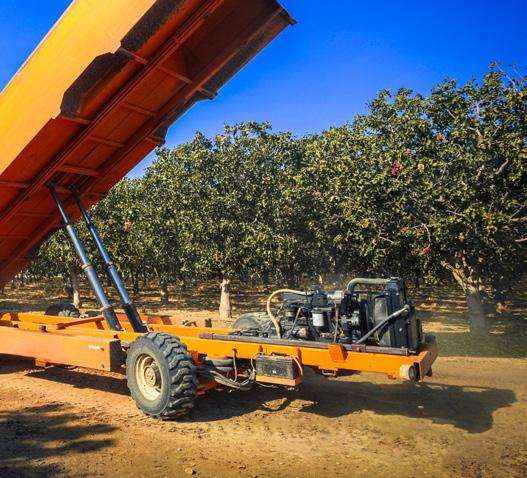
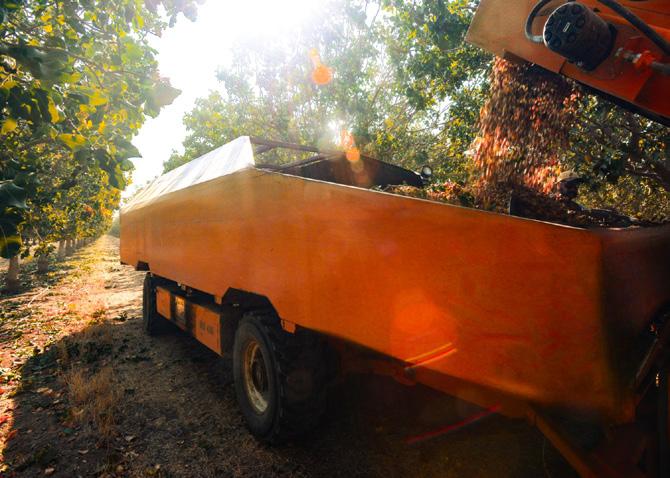
Q. Who would you say was the biggest influence or mentor in your career?
Stephani: For myself, I don’t have just one. We learned quite a bit from our father, watching what he did. The information he’s passed down to us, that’s been a big influence. I have to mention Bob Beede because he’s a real fun gentleman who is now retired but still participates in pistachio management tests. He’s a professor emeritus of UC Cooperative Extension, and he made it enjoyable to get the information.
Rebecca: And also, our first ranch manager, Gary Robinson. When we first got into pistachios, I remember meeting him for the first time, and I was asking him for some direction, a ‘leaping off’ point. Where do I need to get started in my education of becoming a pistachio grower? And he said, “Learn about water. Without water, you’re not going to have a crop.” From there, it really gave me a starting point, and I think that’s really driven me since then.
Q. Talk about how you work together as sisters.
Rebecca: We have a really good setup. It’s kind of the best of both worlds because we have each other as a resource. We can bounce ideas off each other, and we both have unique styles of managing our businesses. We’ve been able to utilize that to see what works and what doesn’t, and it’s only been beneficial to us both.
Stephani: In the beginning, the fun part that I think was really helpful is we’ve got our father’s set of information and there was mine because I’m older. I was in the workforce for 26 years prior to doing this and then Rebecca was coming in new. So, we literally covered three balanced areas of knowl edge and generational information and creativity. It was great because you get three different viewpoints to bring to the table.
Q. How are changing weather patterns affecting how you farm?
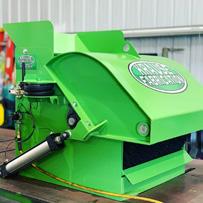

Rebecca: This time last year, we were thinking we were going to have another dry year, so we were all planning for that. Then we got our first pineapple express. Then another pineapple express came along, and we started to realize that all the reservoirs were starting to fill up. Then we had all this snowpack, and a lot of the growers in our area started talking about not only are we going to have a larger-than-expected surface water allocation, but we had to figure out how to best manage all these floodwaters coming through the local rivers and through the delta.
And that’s when we came up with terracing and putting up the berms to start recharging, so we wouldn’t have any spillage in any of our reservoirs. With changing weather patterns, I think it’s a testament to the resiliency of the farmer, being able to think on the spot and the ingenuity which goes into each season.
Stephani: Remain adaptable.

209-754-9636
Toyon Circle, Suite 333 Valley Springs, CA 95252 Complete Walnut and Pecan Hulling And Drying Systems Comments about this article? We want to hear from you. Feel free to email us at article@jcsmarketinginc.com
3474
A conveyor belt loads pistachios into a truck during harvest. Managing water is key to continued profitability, Kaser said. This year, she and other area growers invested in projects that allowed them to capture the excess rainfall to recharge the underground aquifer.
October 2023 www.wcngg.com 63
Harvested pistachios are ready to be moved out of the orchard. Graham said new harvest technology out of Europe may in the future help to solve the problem of trees getting too large for current shaking technology to span.


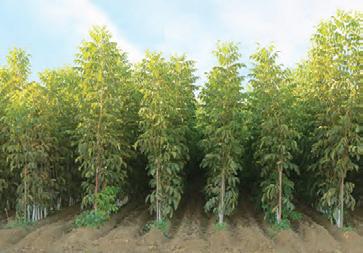




















































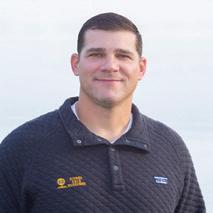













Sierra Gold Nurseries • (530) 674-1145 • sgtrees.com BEST CLONAL HYBRID ROOTSTOCKS PISTACHIOS WALNUTS ALMONDS CONTACT YOUR LOCAL FIELD REPRESENTATIVE PAUL SMITH Butte, Glenn, Tehama & Shasta (530) 517-9338 paul@sgtrees.com BOB FURMIDGE Yuba, Sutter, Colusa, Yolo, Solano, Sacramento & Placer (530) 755-7139 • bob@sgtrees.com RANDY FASANI San Joaquin, Stanislaus, Merced & Madera | (209) 988-7333 randy@sgtrees.com JOSH BERGMAN Fresno, Kings, Tulare & Kern (559) 260-6551 josh@sgtrees.com MATTHEW “BUBBA” HADDON Fresno, Kings, Tulare & Kern (661) 747-3967 • matthew@sgtrees.com Almonds · Walnuts · Pistachios EXPERIENCED ONSITE FIELD SERVICE TO HELP YOU AT EVERY STEP






























 |Director of Technical Services, Western Agricultural Processors Association
|Director of Technical Services, Western Agricultural Processors Association



 By RICH KREPS | CCA, SSp., Contributing Writer
By RICH KREPS | CCA, SSp., Contributing Writer













 By ALMOND BOARD OF CALIFORNIA | Contributing Writer
By ALMOND BOARD OF CALIFORNIA | Contributing Writer



















 By CATHERINE MERLO | Contributing Writer
By CATHERINE MERLO | Contributing Writer


























 By VICKY BOYD | Contributing Writer
By VICKY BOYD | Contributing Writer

 Almond Board of California Board Chair Alexi Rodriguez said a goal of the board’s Thea Project is to provide a fresh viewpoint on allocation of market development funds and resources.
Almond Board of California Board Chair Alexi Rodriguez said a goal of the board’s Thea Project is to provide a fresh viewpoint on allocation of market development funds and resources.





























 By KRISTIN PLATTS | Digital Content Editor
By KRISTIN PLATTS | Digital Content Editor













 By TOBIAS OKER | UCCE Soils and Irrigation Advisor, Kern County
By TOBIAS OKER | UCCE Soils and Irrigation Advisor, Kern County



































































